
We could not find any results for:
Make sure your spelling is correct or try broadening your search.
| Share Name | Share Symbol | Market | Type |
|---|---|---|---|
| TriSalus Life Sciences Inc | NASDAQ:TLSI | NASDAQ | Common Stock |
| Price Change | % Change | Share Price | Bid Price | Offer Price | High Price | Low Price | Open Price | Shares Traded | Last Trade | |
|---|---|---|---|---|---|---|---|---|---|---|
| -1.98 | -20.75% | 7.56 | 7.70 | 11.00 | 9.00 | 6.80 | 9.00 | 353,134 | 00:50:01 |
UNITED STATES
SECURITIES AND EXCHANGE COMMISSION
WASHINGTON, D.C. 20549
FORM
CURRENT REPORT
Pursuant to Section 13 or 15(d) of the Securities Exchange Act of 1934
Date of Report (Date of earliest event reported):
(Exact name of Registrant as Specified in Its Charter)
| (State or Other Jurisdiction of Incorporation) |
(Commission File Number) | (IRS Employer Identification No.) |
| (Address of Principal Executive Offices) | (Zip Code) |
(
(Registrant’s Telephone Number, Including Area Code)
Not Applicable
(Former Name or Former Address, if Changed Since Last Report)
Check the appropriate box below if the Form 8-K filing is intended to simultaneously satisfy the filing obligation of the registrant under any of the following provisions (see General Instructions A.2. below):
| Written communications pursuant to Rule 425 under the Securities Act (17 CFR 230.425) |
| Soliciting material pursuant to Rule 14a-12 under the Exchange Act (17 CFR 240.14a-12) |
| Pre-commencement communications pursuant to Rule 14d-2(b) under the Exchange Act (17 CFR 240.14d-2(b)) |
| Pre-commencement communications pursuant to Rule 13e-4(c) under the Exchange Act (17 CFR 240.13e-4(c)) |
Securities registered pursuant to Section 12(b) of the Act:
| Title of each class |
Trading symbol(s) |
Name of each exchange on which registered | ||
Indicate by check mark whether the registrant is an emerging growth company as defined in Rule 405 of the Securities Act of 1933 (§ 230.405 of this chapter) or Rule 12b-2 of the Securities Exchange Act of 1934 (§240.12b-2 of this chapter).
Emerging growth company
If an emerging growth company, indicate by check
mark if the registrant has elected not to use the extended transition period for complying with any new or revised financial accounting
standards provided pursuant to Section 13(a) of the Exchange Act.
Item 2.02. Results of Operations and Financial Condition.
TriSalus Life Sciences, Inc. (the “Company”) may use a slide presentation, in whole or in part, from time to time in presentation to investors, analysts and others that includes preliminary sales information for the year ended December 31, 2023, as well as a business and product update. A copy of the slide presentation is furnished as Exhibit 99.1 to this Current Report on Form 8-K and incorporated by reference herein. A copy of the slide presentation is also available on the Company’s website at https://trisaluslifesci.com/.
The information in this Item 2.02, including Exhibit 99.1, is furnished and shall not be deemed “filed” for purposes of Section 18 of the Securities Exchange Act of 1934, as amended (the “Exchange Act”), or otherwise subject to liabilities under that section, and shall not be deemed to be incorporated by reference into the filings of the registrant under the Securities Act of 1933, as amended, or the Exchange Act, regardless of any general incorporation language in such filings. This Current Report on 8-K will not be deemed an admission as to the materiality of any information contained in this Item 2.02, including Exhibit 99.1.
Item 9.01. Financial Statements and Exhibits.
(d) Exhibits
| Exhibit No. | Description | |
| 99.1 | Investor Presentation, dated January 2024. | |
| 104 | Cover page Interactive data file (embedded within the inline XBRL document). |
SIGNATURES
Pursuant to the requirements of the Securities Exchange Act of 1934, the registrant has duly caused this report to be signed on its behalf by the undersigned hereunto duly authorized.
Dated: January 5, 2024
| TRISALUS LIFE SCIENCES, INC. | ||
| By: | /s/ Sean Murphy | |
| Sean Murphy | ||
| Chief Financial Officer | ||
Exhibit 99.1
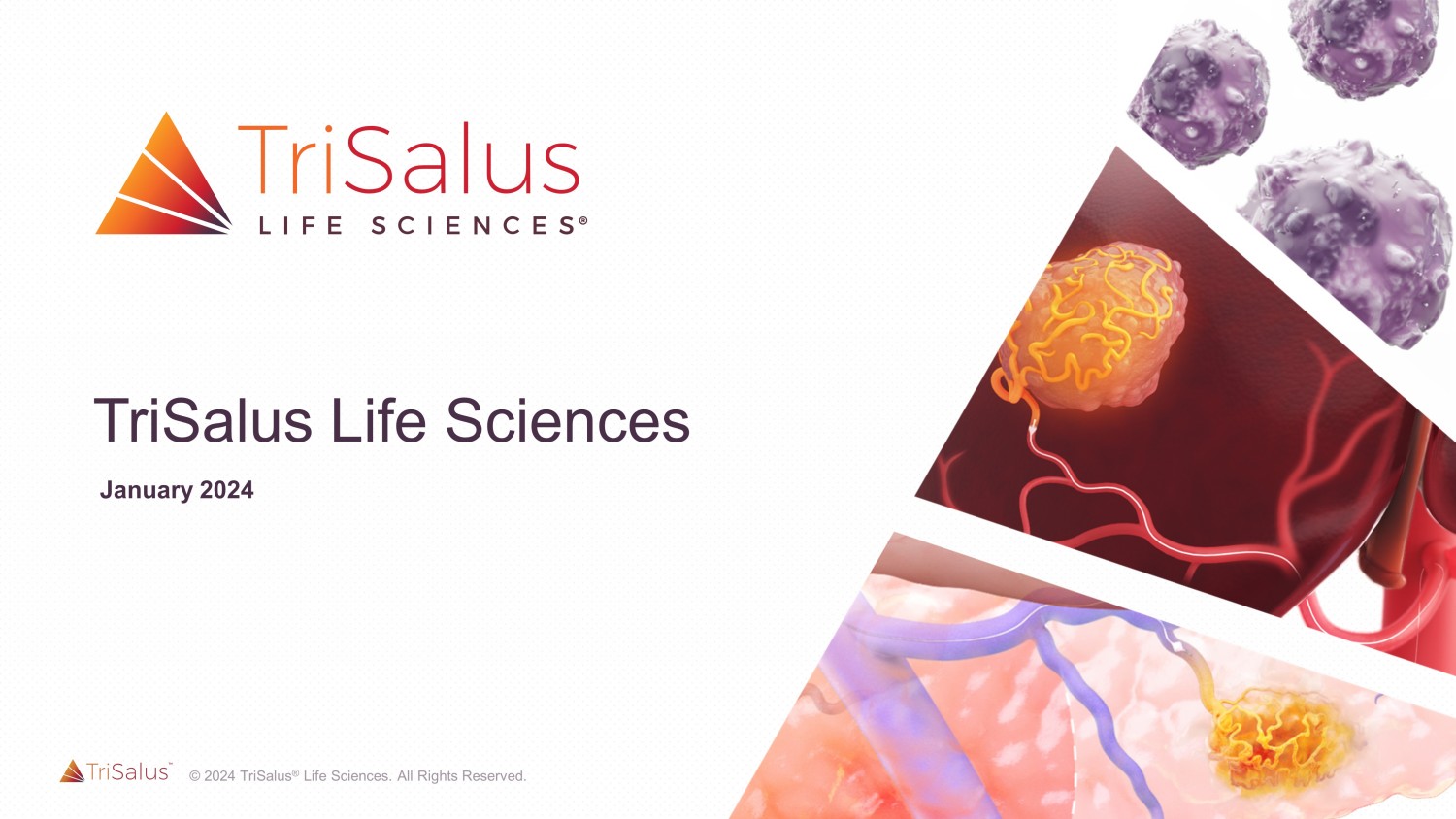
1 TriSalus Life Sciences January 2024
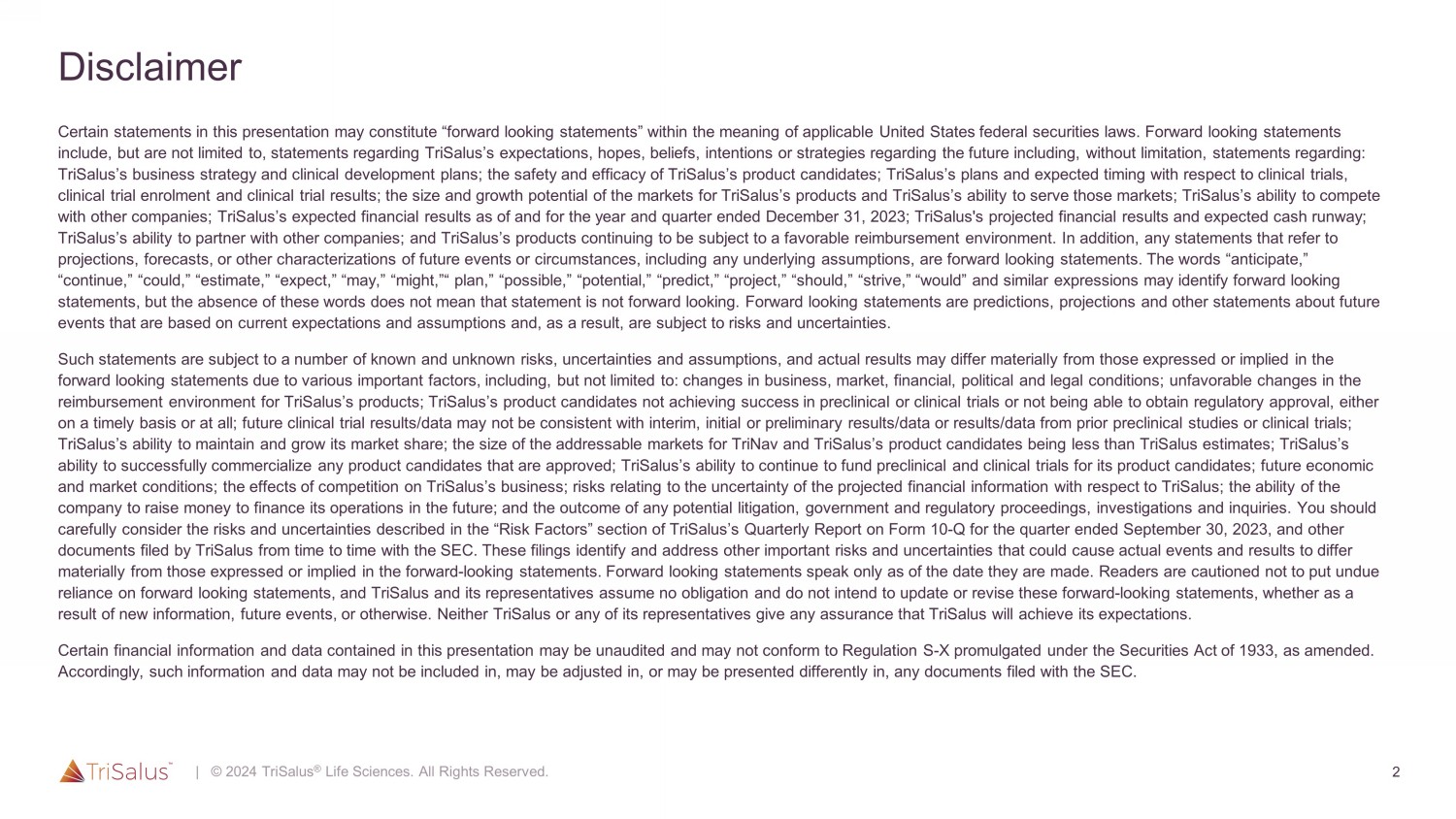
2 Disclaimer Certain statements in this presentation may constitute “forward looking statements” within the meaning of applicable United S tat es federal securities laws. Forward looking statements include, but are not limited to, statements regarding TriSalus’s expectations, hopes, beliefs, intentions or strategies regarding the future including, without limitation, statements regardi ng : TriSalus’s business strategy and clinical development plans; the safety and efficacy of TriSalus’s product candidates; TriSalus’s plans and expected timing with respect to clinical trials, clinical trial enrolment and clinical trial results; the size and growth potential of the markets for TriSalus’s products and TriSalus’s ability to serve those markets; TriSalus’s ability to compete with other companies; TriSalus’s expected financial results as of and for the year and quarter ended December 31, 2023; TriSalus's projected financial results and expected cash runway; TriSalus’s ability to partner with other companies; and TriSalus’s products continuing to be subject to a favorable reimbursement environment. In addition, any statements that refer to projections, forecasts, or other characterizations of future events or circumstances, including any underlying assumptions, a re forward looking statements. The words “anticipate,” “continue,” “could,” “estimate,” “expect,” “may,” “might,”“ plan,” “possible,” “potential,” “predict,” “project,” “should,” “ str ive,” “would” and similar expressions may identify forward looking statements, but the absence of these words does not mean that statement is not forward looking. Forward looking statements ar e p redictions, projections and other statements about future events that are based on current expectations and assumptions and, as a result, are subject to risks and uncertainties. Such statements are subject to a number of known and unknown risks, uncertainties and assumptions, and actual results may dif fer materially from those expressed or implied in the forward looking statements due to various important factors, including, but not limited to: changes in business, market, fina nci al, political and legal conditions; unfavorable changes in the reimbursement environment for TriSalus’s products; TriSalus’s product candidates not achieving success in preclinical or clinical trials or not being able to obtain regulatory approval, e it her on a timely basis or at all; future clinical trial results/data may not be consistent with interim, initial or preliminary re sul ts/data or results/data from prior preclinical studies or clinical trials; TriSalus’s ability to maintain and grow its market share; the size of the addressable markets for TriNav and TriSalus’s product candidates being less than TriSalus estimates; TriSalus’s ability to successfully commercialize any product candidates that are approved; TriSalus’s ability to continue to fund preclinical and clinical trials for its product candidates; future economic and market conditions; the effects of competition on TriSalus’s business; risks relating to the uncertainty of the projected financial information with respect to TriSalus ; the ability of the company to raise money to finance its operations in the future; and the outcome of any potential litigation, government and r egu latory proceedings, investigations and inquiries. You should carefully consider the risks and uncertainties described in the “Risk Factors” section of TriSalus’s Quarterly Report on Form 10 - Q for the quarter ended September 30, 2023, and other documents filed by TriSalus from time to time with the SEC. These filings identify and address other important risks and uncertainties that could cause a ct ual events and results to differ materially from those expressed or implied in the forward - looking statements. Forward looking statements speak only as of the da te they are made. Readers are cautioned not to put undue reliance on forward looking statements, and TriSalus and its representatives assume no obligation and do not intend to update or revise these forward - looking statements, whether as a result of new information, future events, or otherwise. Neither TriSalus or any of its representatives give any assurance that TriSalus will achieve its expectations. Certain financial information and data contained in this presentation may be unaudited and may not conform to Regulation S - X pro mulgated under the Securities Act of 1933, as amended. Accordingly, such information and data may not be included in, may be adjusted in, or may be presented differently in, any do cum ents filed with the SEC.
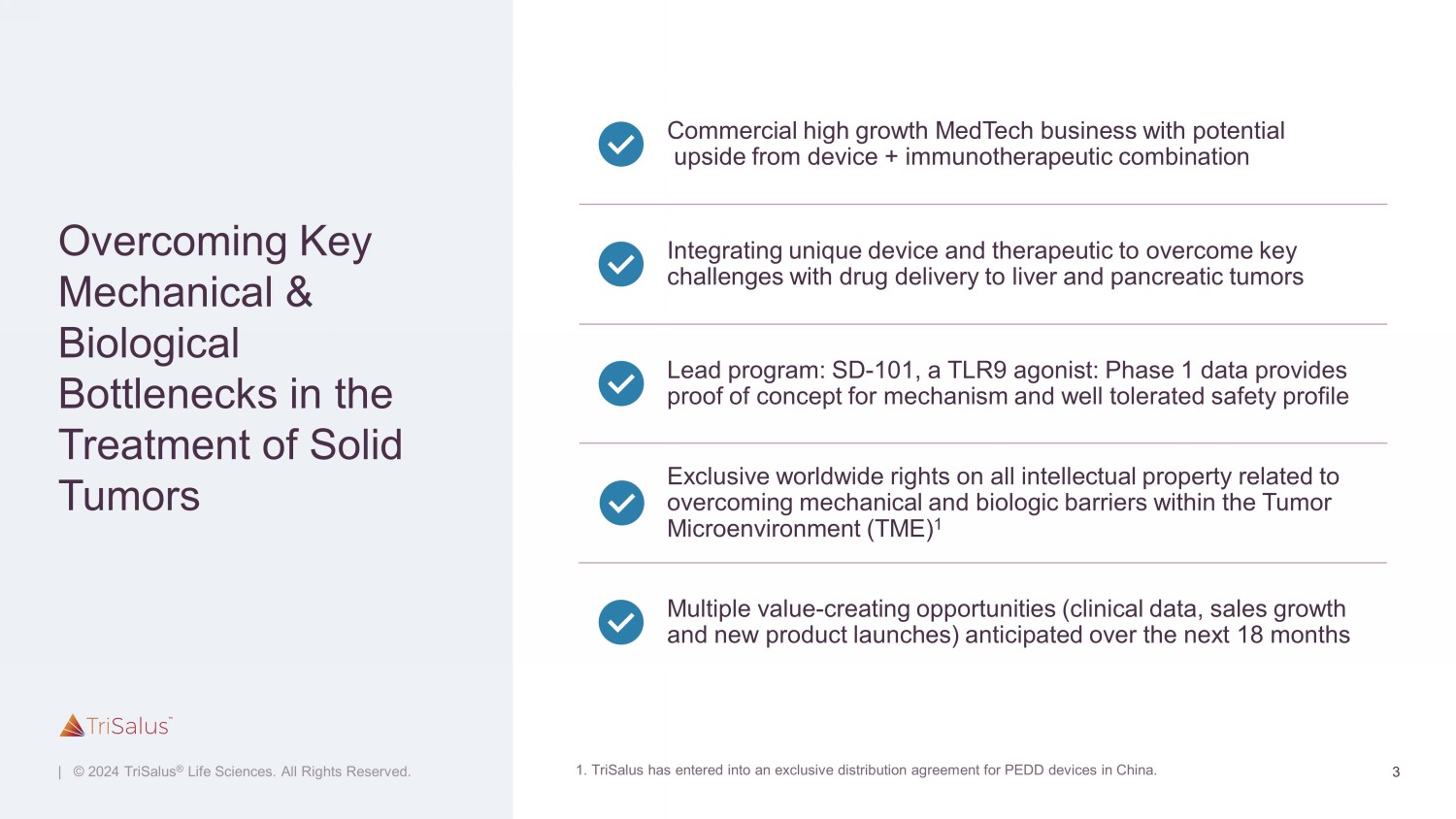
3 ` Overcoming Key Mechanical & Biological Bottlenecks in the Treatment of Solid Tumors Commercial high growth MedTech business with potential upside from device + immunotherapeutic combination Integrating unique device and therapeutic to overcome key challenges with drug delivery to liver and pancreatic tumors Lead program: SD - 101, a TLR9 agonist: Phase 1 data provides proof of concept for mechanism and well tolerated safety profile Multiple value - creating opportunities (clinical data, sales growth and new product launches) anticipated over the next 18 months Exclusive worldwide rights on all intellectual property related to overcoming mechanical and biologic barriers within the Tumor Microenvironment (TME) 1
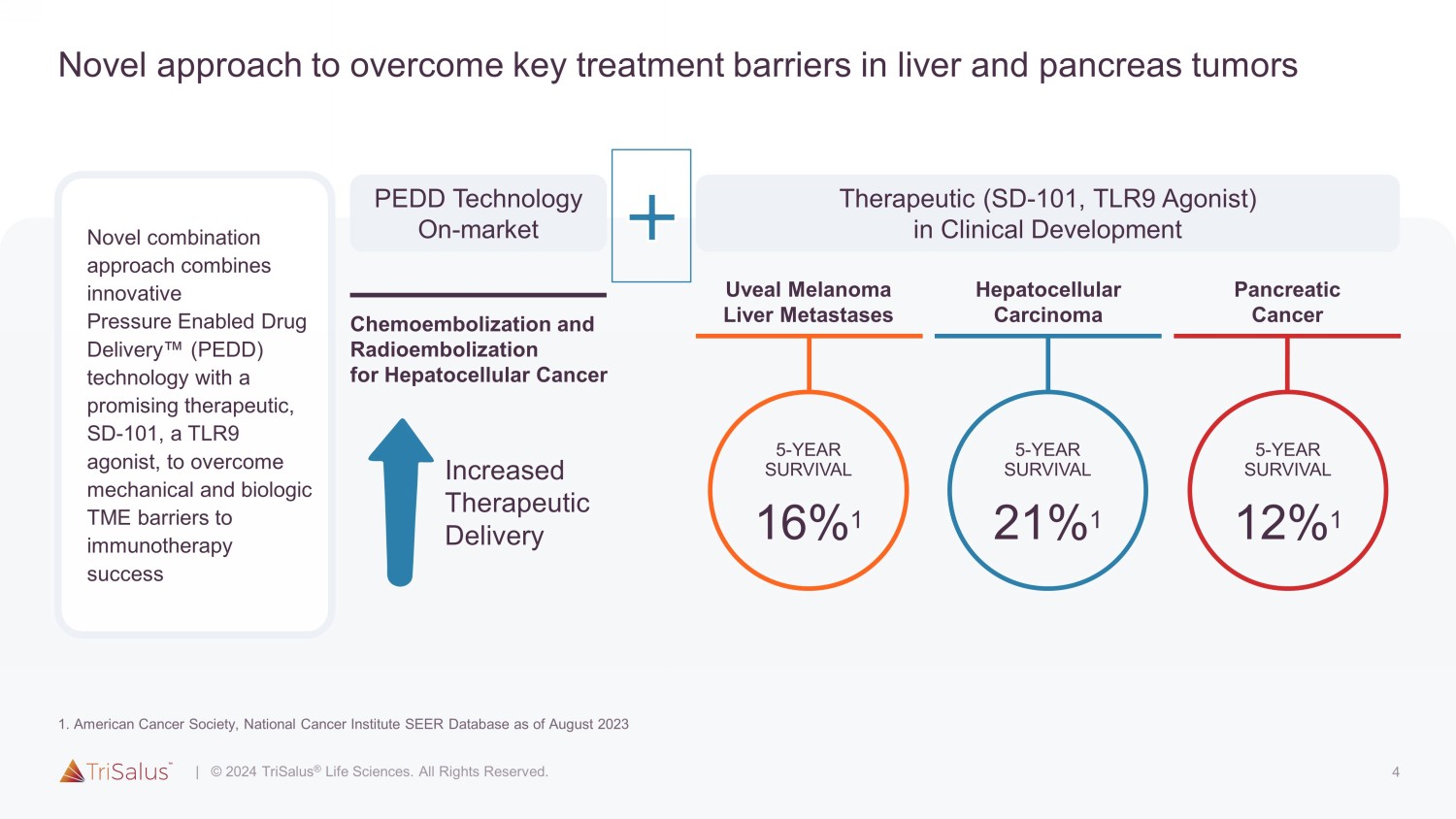
4 Novel approach to overcome key treatment barriers in liver and pancreas tumors Novel combination approach combines innovative Pressure Enabled Drug Delivery Π(PEDD) technology with a promising therapeutic, SD - 101, a TLR9 agonist, to overcome mechanical and biologic TME barriers to immunotherapy success PEDD Technology On - market Therapeutic (SD - 101, TLR9 Agonist) in Clinical Development Uveal Melanoma Liver Metastases Hepatocellular Carcinoma Chemoembolization and Radioembolization for Hepatocellular Cancer Pancreatic Cancer 5 - YEAR SURVIVAL 16% 1 5 - YEAR SURVIVAL 21% 1 5 - YEAR SURVIVAL 12% 1 Increased Therapeutic Delivery

5 Two important barriers to immunotherapy success in liver and pancreatic tumors 1. Mechanical Barrier 1 - 3 H igh intra - tumoral pressure in solid tumors limits efficient drug delivery to tumor 2. Biologic Barrier 4 Immunosuppression in TME limits activity of therapeutic agents Limited drug uptake due to collapsed vessel (<1% in some settings with IV delivery)
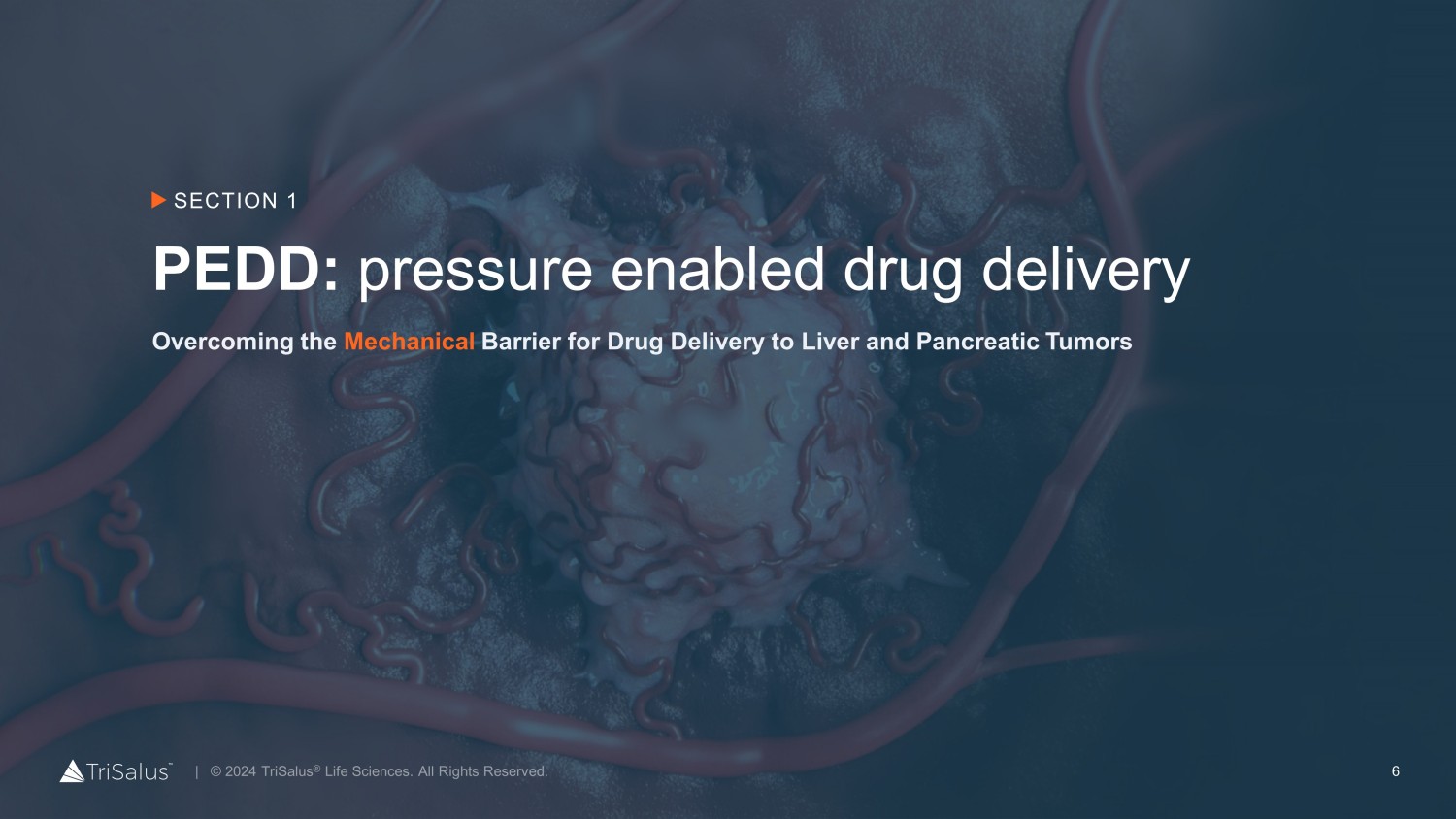
6 6 PEDD: pressure enabled drug delivery SECTION 1 Overcoming the Mechanical Barrier for Drug Delivery to Liver and Pancreatic Tumors
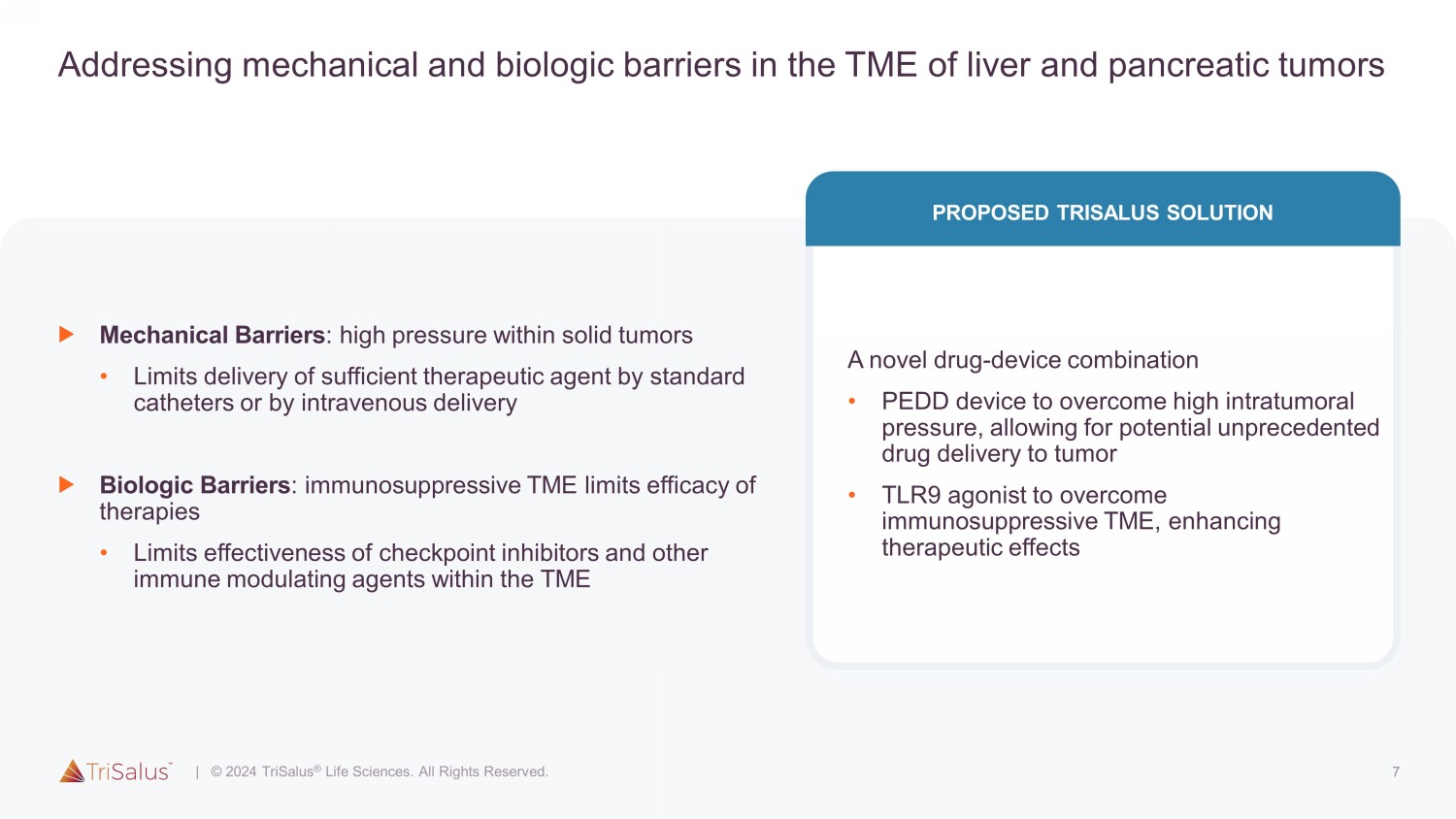
7 Addressing mechanical and biologic barriers in the TME of liver and pancreatic tumors Mechanical Barriers : high pressure within solid tumors • Limits delivery of sufficient therapeutic agent by standard catheters or by intravenous delivery Biologic Barriers : immunosuppressive TME limits efficacy of therapies • Limits effectiveness of checkpoint inhibitors and other immune modulating agents within the TME A novel drug - device combination • PEDD device to overcome high intratumoral pressure, allowing for potential unprecedented drug delivery to tumor • TLR9 agonist to overcome immunosuppressive TME, enhancing therapeutic effects PROPOSED TRISALUS SOLUTION
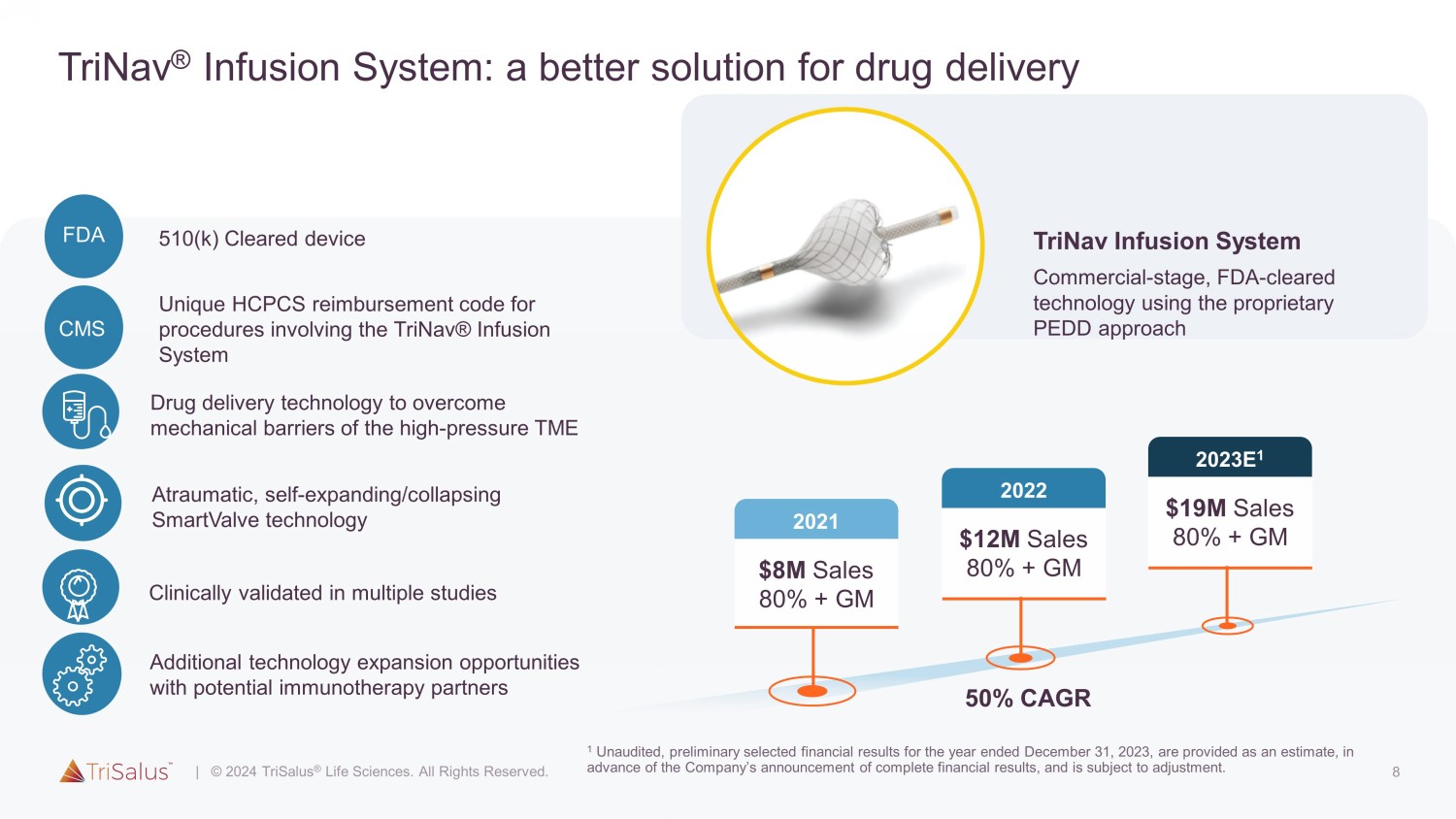
8 TriNav ® Infusion System: a better solution for drug delivery Additional technology expansion opportunities with potential immunotherapy partners Clinically validated in multiple studies Atraumatic, self - expanding/collapsing SmartValve technology Drug delivery technology to overcome mechanical barriers of the high - pressure TME 510(k) Cleared device FDA TriNav Infusion System Commercial - stage, FDA - cleared technology using the proprietary PEDD approach $8M Sales 80% + GM 2021 50% CAGR $12M Sales 80% + GM 2022 $19M Sales 80% + GM 2023E 1 Unique HCPCS reimbursement code for procedures involving the TriNav® Infusion System CMS
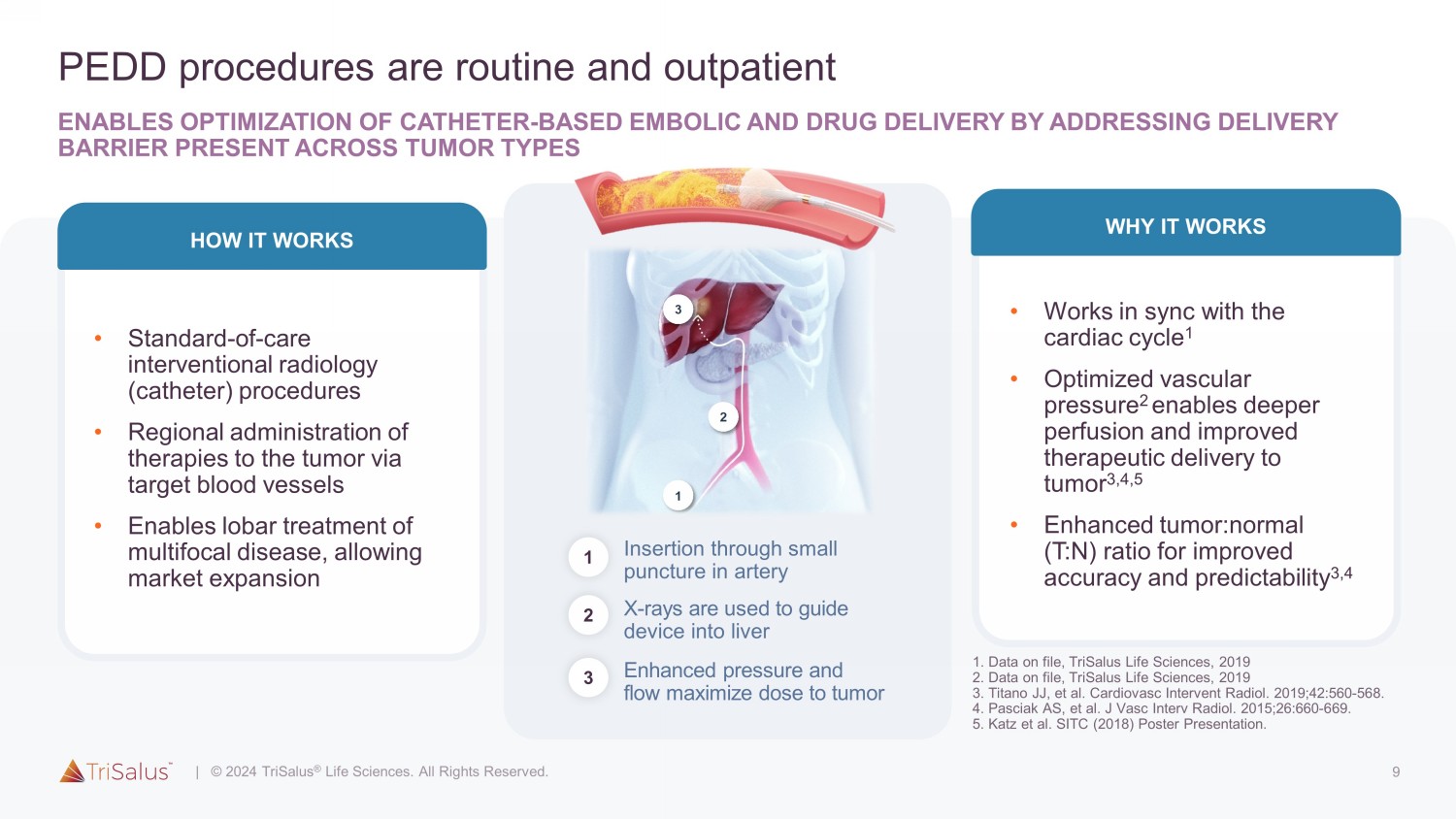
9 PEDD procedures are routine and outpatient ENABLES OPTIMIZATION OF CATHETER - BASED EMBOLIC AND DRUG DELIVERY BY ADDRESSING DELIVERY BARRIER PRESENT ACROSS TUMOR TYPES • Standard - of - care interventional radiology (catheter) procedures • Regional administration of therapies to the tumor via target blood vessels • Enables lobar treatment of multifocal disease, allowing market expansion HOW IT WORKS • Works in sync with the cardiac cycle 1 • Optimized vascular pressure 2 enables deeper perfusion and improved therapeutic delivery to tumor 3,4,5 • Enhanced tumor:normal (T:N) ratio for improved accuracy and predictability 3,4 WHY IT WORKS Enhanced pressure and flow maximize dose to tumor 3 X - rays are used to guide device into liver 2 Insertion through small puncture in artery 1
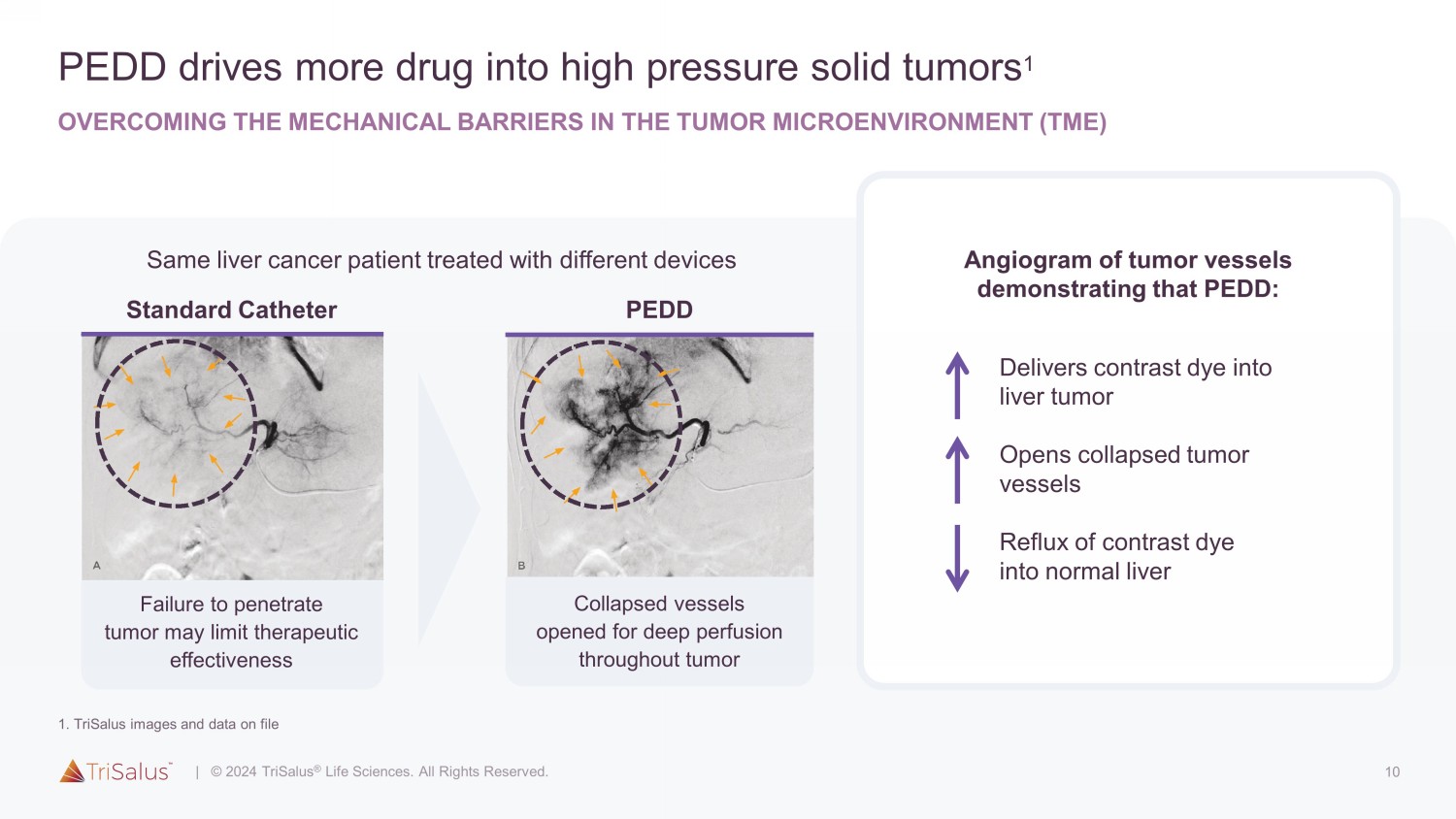
10 PEDD drives more drug into high pressure solid tumors 1 OVERCOMING THE MECHANICAL BARRIERS IN THE TUMOR MICROENVIRONMENT (TME) Angiogram of tumor vessels demonstrating that PEDD: Delivers contrast dye into liver tumor Opens collapsed tumor vessels Reflux of contrast dye into normal liver Surefire increases pressure during infusion, overcoming tumor pressure 6 PEDD Standard End-hole Catheter (EH) Surefire increases pressure during infusion, overcoming tumor pressure 6 PEDDStandard Catheter Standard Catheter Failure to penetrate tumor may limit therapeutic effectiveness PEDD Surefire increases pressure during infusion, overcoming tumor pressure 6 PEDD Standard End-hole Catheter (EH) Surefire increases pressure during infusion, overcoming tumor pressure 6 PEDDStandard Catheter Collapsed vessels opened for deep perfusion throughout tumor Same liver cancer patient treated with different devices
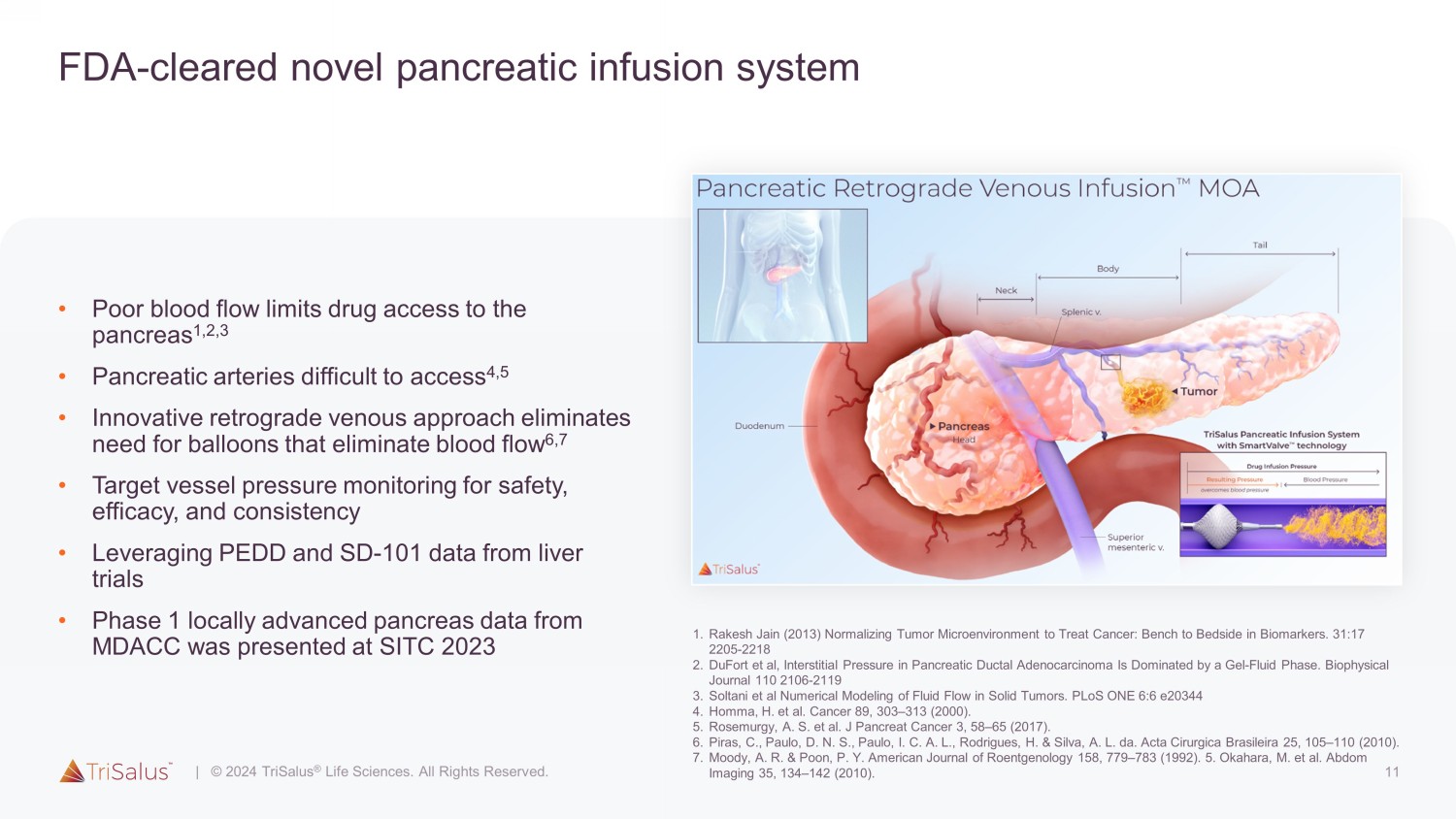
11 FDA - cleared novel pancreatic infusion system • Poor blood flow limits drug access to the pancreas 1,2,3 • Pancreatic arteries difficult to access 4,5 • Innovative retrograde venous approach eliminates need for balloons that eliminate blood flow 6,7 • Target vessel pressure monitoring for safety, efficacy, and consistency • Leveraging PEDD and SD - 101 data from liver trials • Phase 1 locally advanced pancreas data from MDACC was presented at SITC 2023
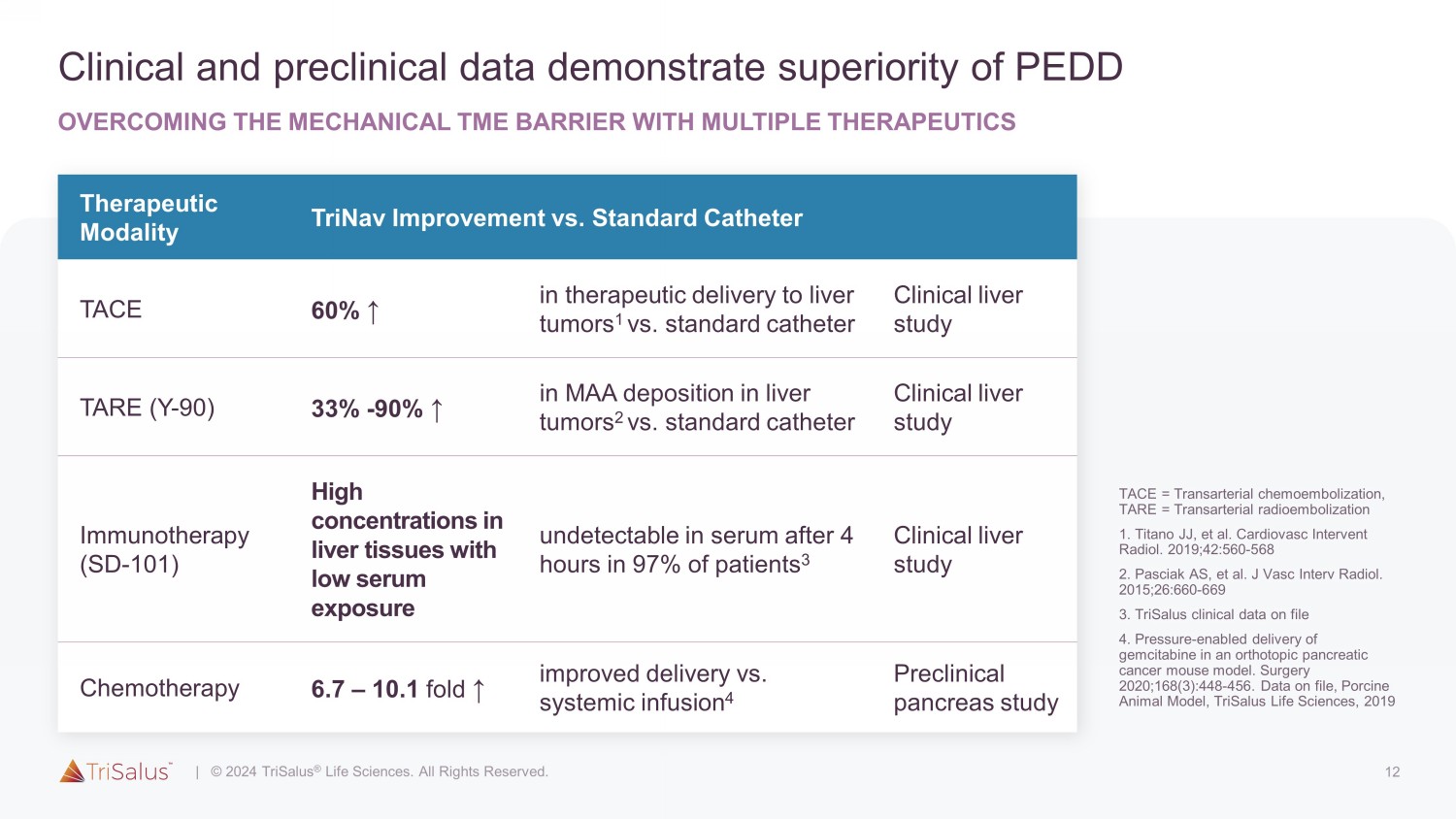
12 Clinical and preclinical data demonstrate superiority of PEDD OVERCOMING THE MECHANICAL TME BARRIER WITH MULTIPLE THERAPEUTICS Therapeutic Modality TriNav Improvement vs. Standard Catheter TACE 60% ↑ in therapeutic delivery to liver tumors 1 vs. standard catheter Clinical liver study TARE (Y - 90) 33% - 90% ↑ in MAA deposition in liver tumors 2 vs. standard catheter Clinical liver study Immunotherapy (SD - 101) High concentrations in liver tissues with low serum exposure undetectable in serum after 4 hours in 97% of patients 3 Clinical liver study Chemotherapy 6.7 – 10.1 fold ↑ improved delivery vs. systemic infusion 4 Preclinical pancreas study
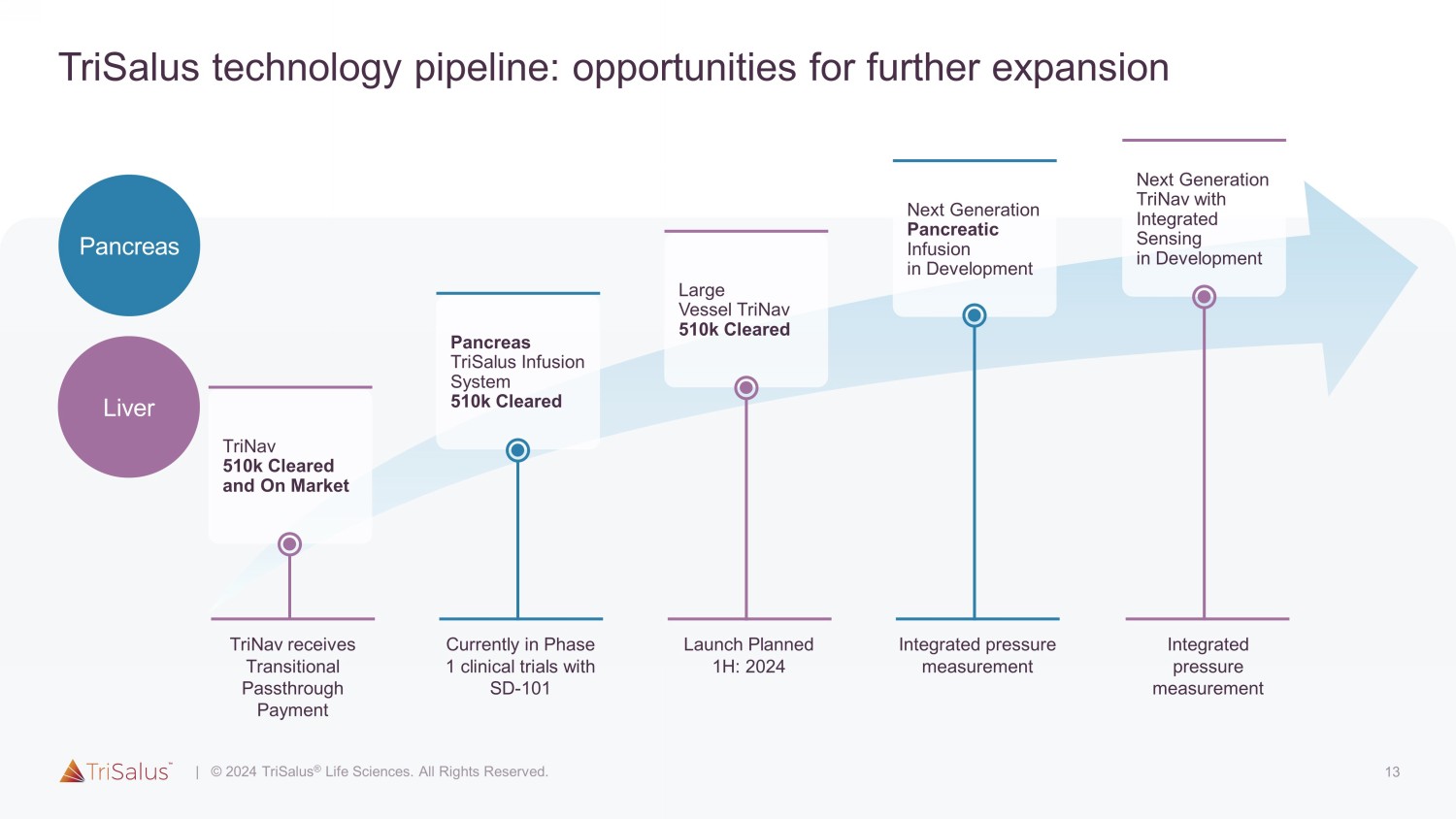
13 TriSalus technology pipeline: opportunities for further expansion Liver Pancreas Integrated pressure measurement Next Generation Pancreatic Infusion in Development Launch Planned 1H: 2024 Large Vessel TriNav 510k Cleared Currently in Phase 1 clinical trials with SD - 101 Pancreas TriSalus Infusion System 510k Cleared TriNav receives Transitional Passthrough Payment TriNav 510k Cleared and On Market Integrated pressure measurement Next Generation TriNav with Integrated Sensing in Development
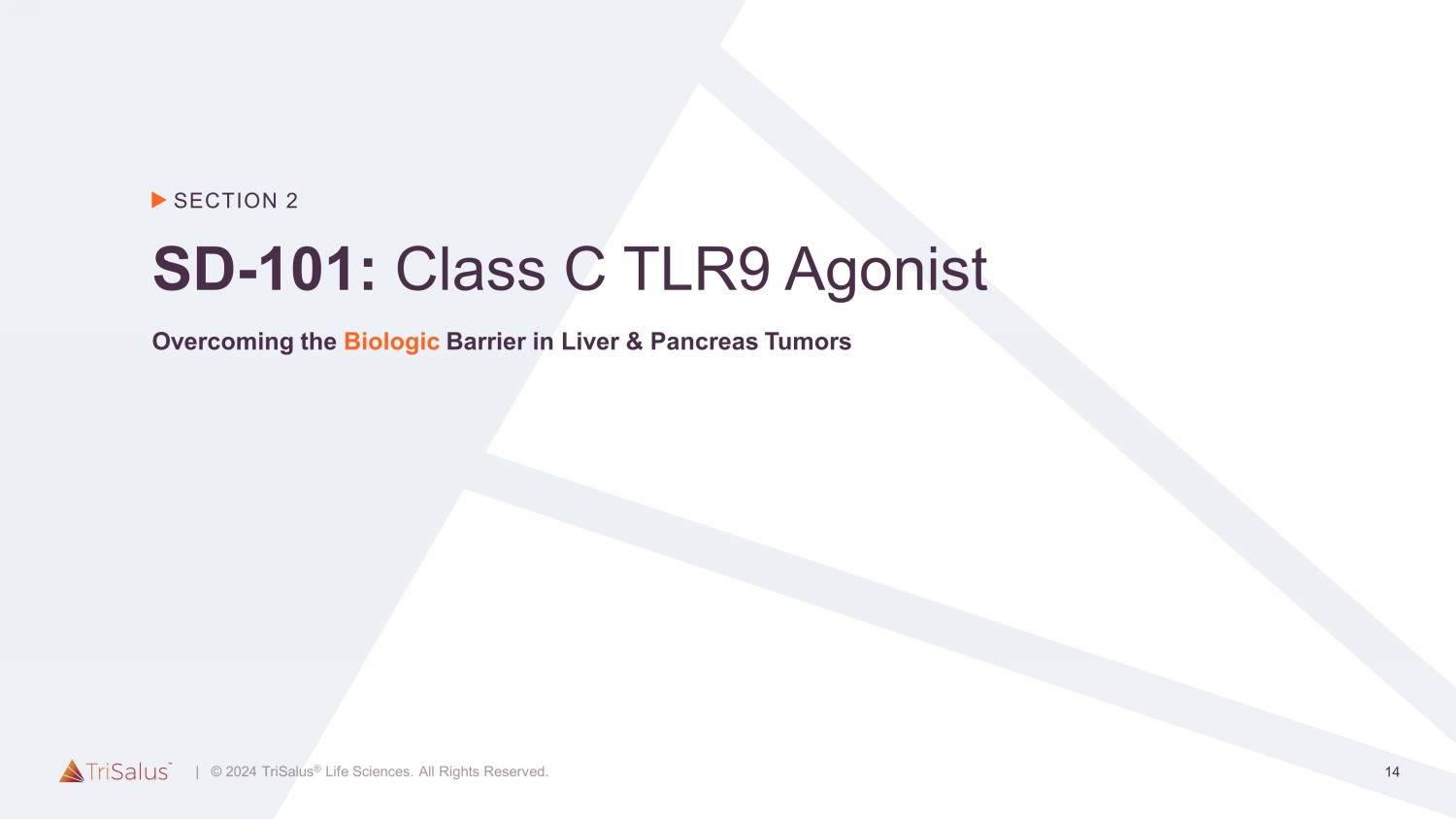
14 14 SD - 101: Class C TLR9 Agonist SECTION 2 Overcoming the Biologic Barrier in Liver & Pancreas Tumors
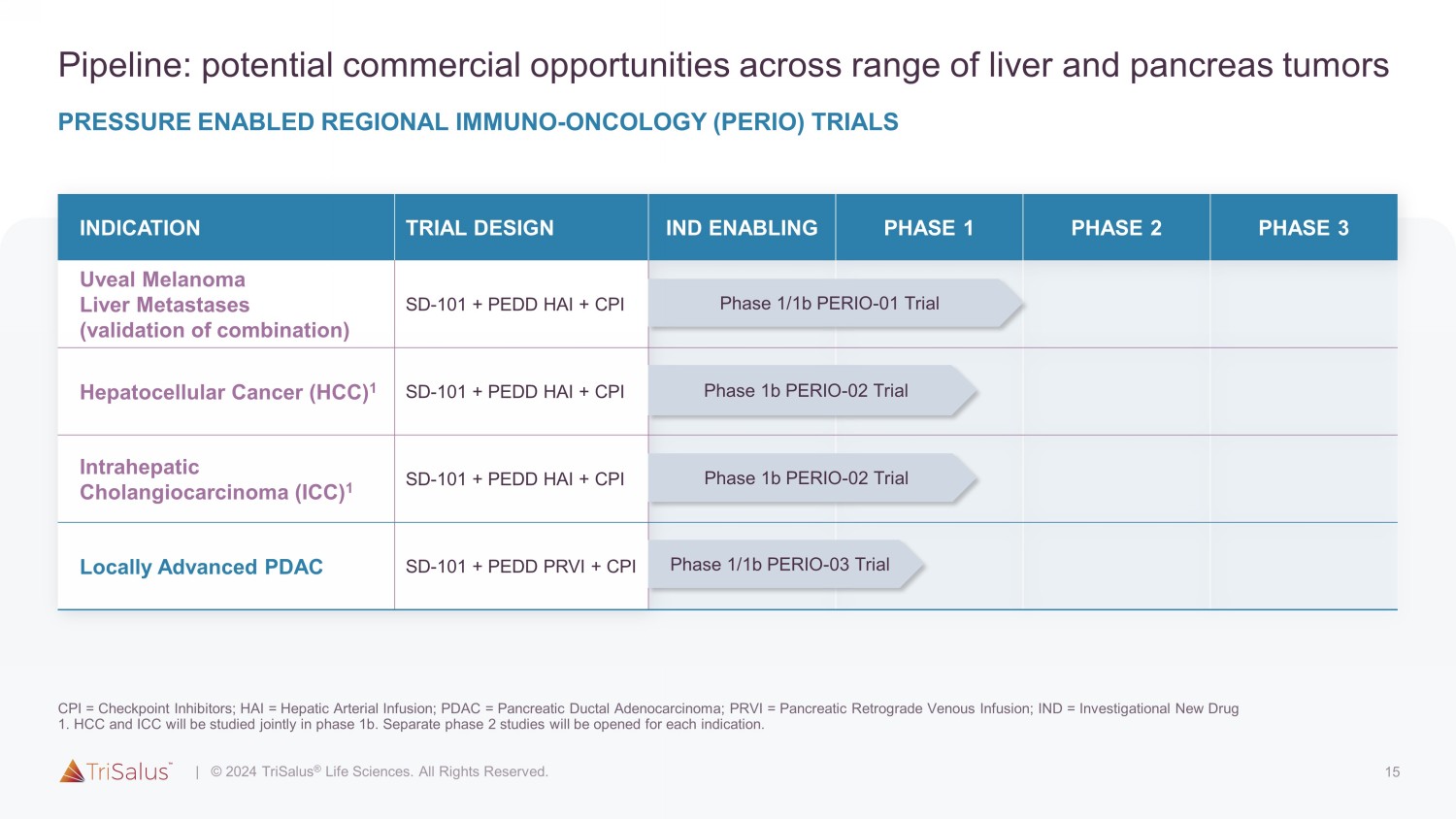
15 Pipeline: potential commercial opportunities across range of liver and pancreas tumors INDICATION TRIAL DESIGN IND ENABLING PHASE 1 PHASE 2 PHASE 3 Uveal Melanoma Liver Metastases (validation of combination) SD - 101 + PEDD HAI + CPI Hepatocellular Cancer (HCC) 1 SD - 101 + PEDD HAI + CPI Intrahepatic Cholangiocarcinoma (ICC) 1 SD - 101 + PEDD HAI + CPI Locally Advanced PDAC SD - 101 + PEDD PRVI + CPI Phase 1/1b PERIO - 01 Trial Phase 1b PERIO - 02 Trial Phase 1b PERIO - 02 Trial Phase 1/1b PERIO - 03 Trial PRESSURE ENABLED REGIONAL IMMUNO - ONCOLOGY (PERIO) TRIALS
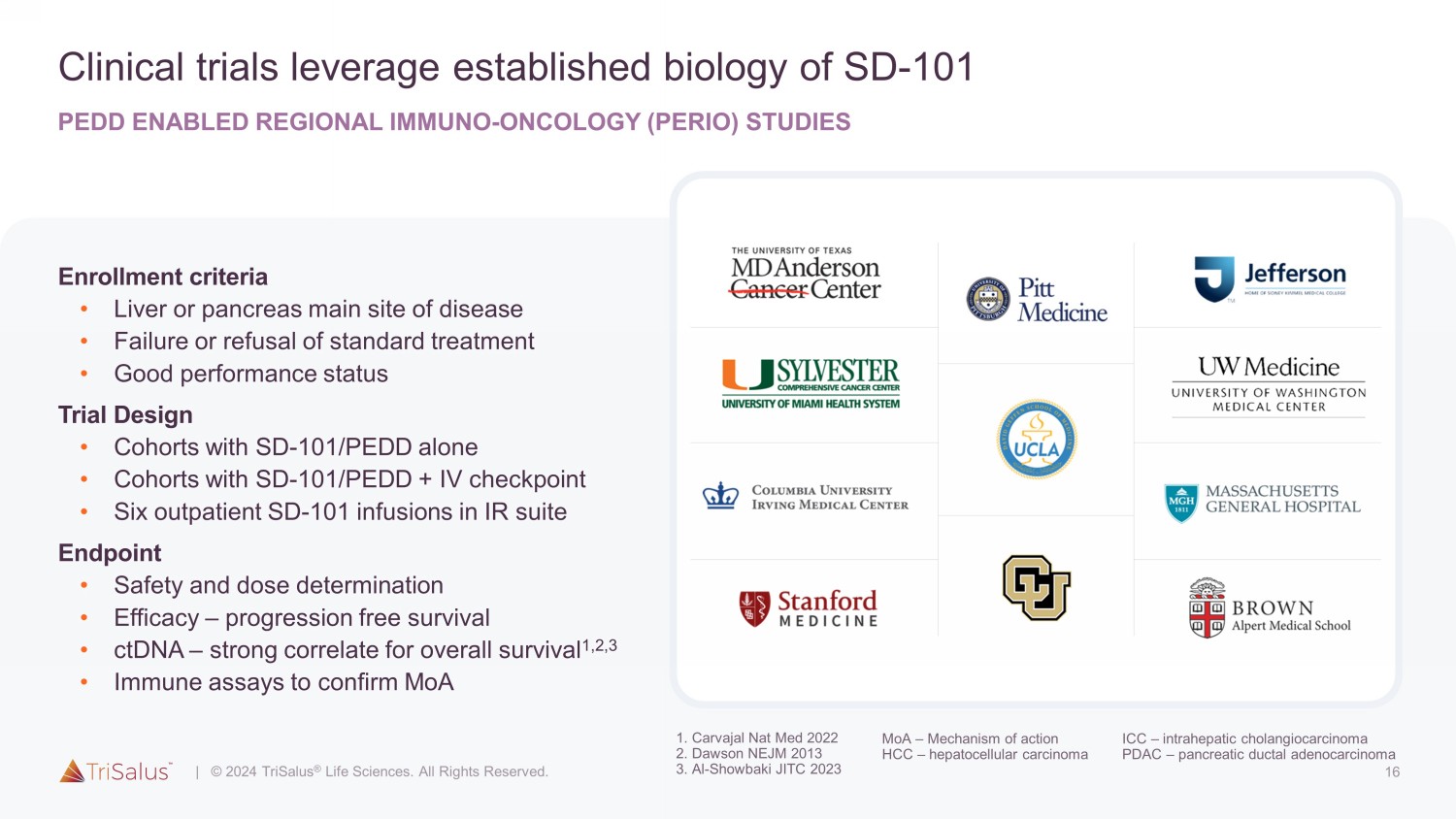
16 Clinical trials leverage established biology of SD - 101 Enrollment criteria • Liver or pancreas main site of disease • Failure or refusal of standard treatment • Good performance status Trial Design • Cohorts with SD - 101/PEDD alone • Cohorts with SD - 101/PEDD + IV checkpoint • Six outpatient SD - 101 infusions in IR suite Endpoint • Safety and dose determination • Efficacy – progression free survival • ctDNA – strong correlate for overall survival 1,2,3 • Immune assays to confirm MoA PEDD ENABLED REGIONAL IMMUNO - ONCOLOGY (PERIO) STUDIES
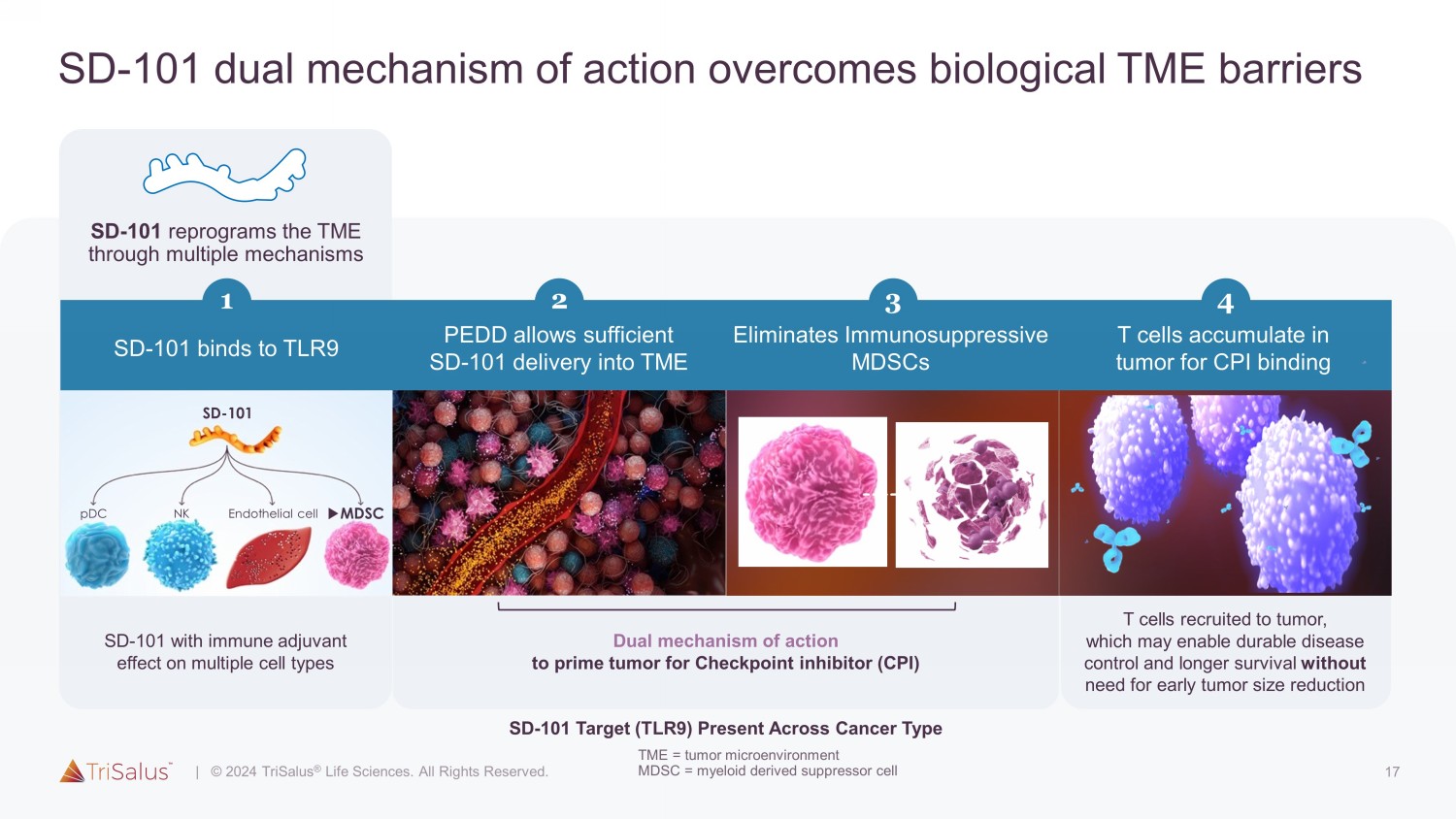
17 SD - 101 dual mechanism of action overcomes biological TME barriers SD - 101 binds to TLR9 MDSC SD - 101 Endothelial cell 3 NK pDC Eliminates Immunosuppressive MDSCs 1 2 PEDD allows sufficient SD - 101 delivery into TME SD - 101 with immune adjuvant effect on multiple cell types Dual mechanism of action to prime tumor for Checkpoint inhibitor (CPI) SD - 101 Target (T LR9) Present Across Cancer Type 4 T cells recruited to tumor, which may enable durable disease control and longer survival without need for early tumor size reduction T cells accumulate in tumor for CPI binding SD - 101 reprograms the TME through multiple mechanisms

18 Clinical proof - of - concept DUAL MOA WITH POTENTIAL TO ENHANCE CHECKPOINT ACTIVITY BOTH IN TME AND SYSTEMICALLY Unresponsive “cold” Tumor Pre - SD - 101 Enhanced CPI Effects in Target Organ and Systemically Responsive “hot” Tumor Post - SD - 101 PEDD + SD - 101 MDSC accumulation T cell paucity Immunotherapy failure Systemic immune stimulation as evidenced by declines in ctDNA with disease control and early evidence for progression free survival 2 MDSC depletion T cell infiltration Enhanced CPI activity PEDD unlocks dual mechanism of action in liver and pancreas 1.
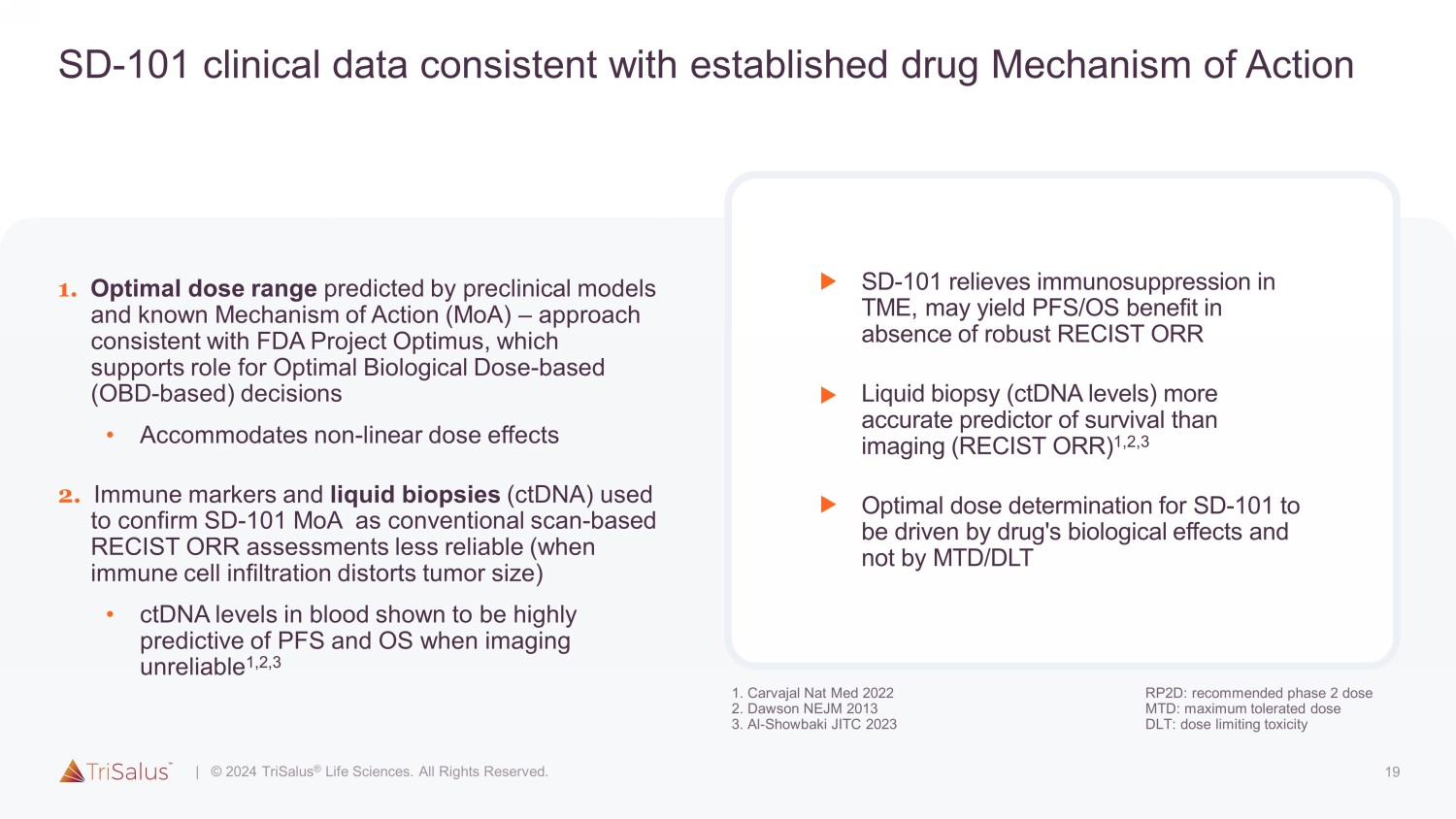
19 SD - 101 clinical data consistent with established drug Mechanism of Action SD - 101 relieves immunosuppression in TME, may yield PFS/OS benefit in absence of robust RECIST ORR Liquid biopsy ( ctDNA levels) more accurate predictor of survival than imaging (RECIST ORR) 1,2,3 Optimal dose determination for SD - 101 to be driven by drug's biological effects and not by MTD/DLT 1. Optimal dose range predicted by preclinical models and known Mechanism of Action ( MoA ) – approach consistent with FDA Project Optimus, which supports role for Optimal Biological Dose - based (OBD - based) decisions • Accommodates non - linear dose effects 2. Immune markers and liquid biopsies ( ctDNA ) used to confirm SD - 101 MoA as conventional scan - based RECIST ORR assessments less reliable (when immune cell infiltration distorts tumor size) • ctDNA levels in blood shown to be highly predictive of PFS and OS when imaging unreliable 1,2,3
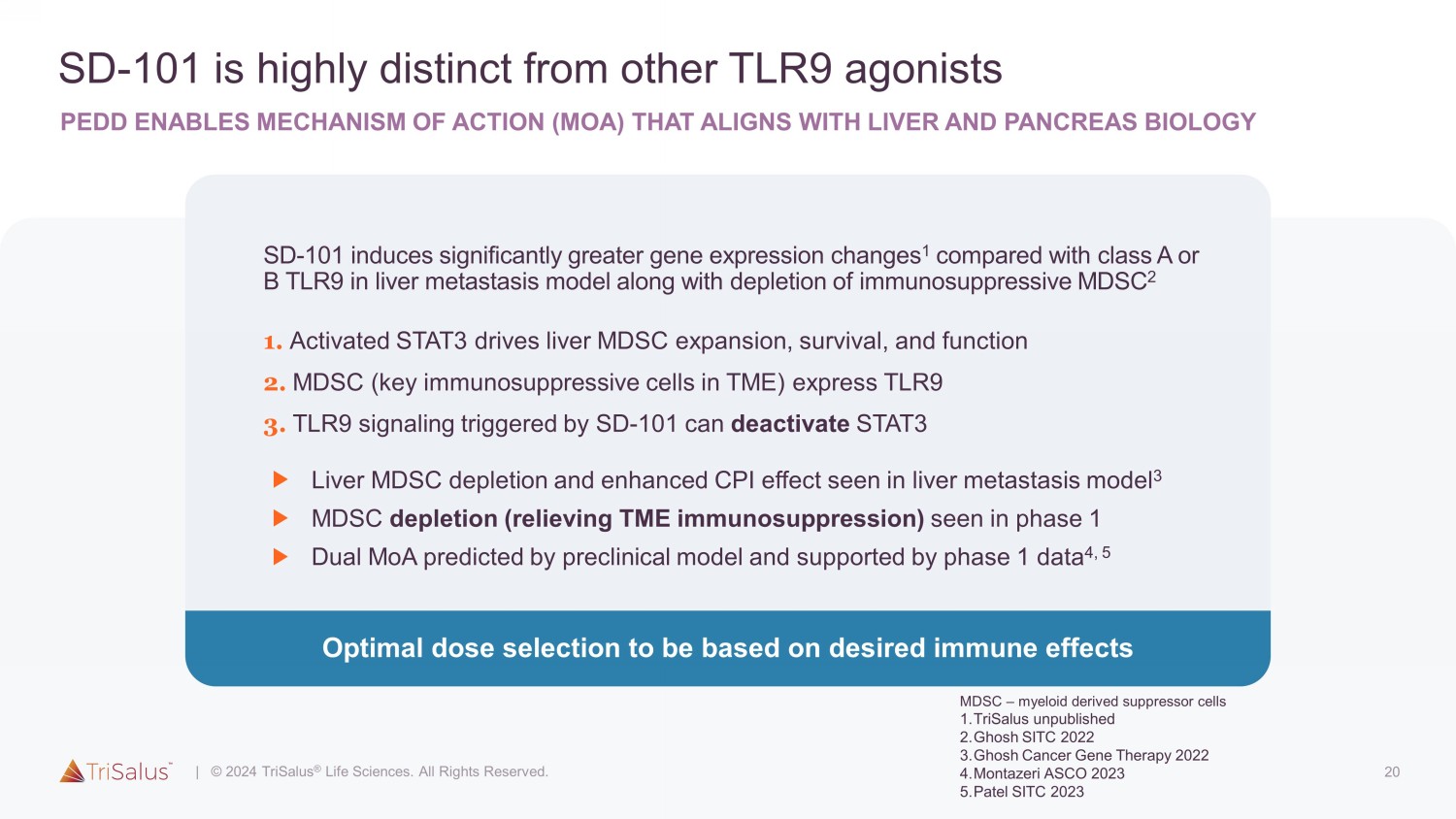
20 SD - 101 is highly distinct from other TLR9 agonists PEDD ENABLES MECHANISM OF ACTION ( MOA ) THAT ALIGNS WITH LIVER AND PANCREAS BIOLOGY MDSC – myeloid derived suppressor cells 1. TriSalus unpublished 2. Ghosh SITC 2022 3. Ghosh Cancer Gene Therapy 2022 4. Montazeri ASCO 2023 5. Patel SITC 2023 SD - 101 induces significantly greater gene expression changes 1 compared with class A or B TLR9 in liver metastasis model along with depletion of immunosuppressive MDSC 2 1. Activated STAT3 drives liver MDSC expansion, survival, and function 2. MDSC (key immunosuppressive cells in TME) express TLR9 3. TLR9 signaling triggered by SD - 101 can deactivate STAT3 • Liver MDSC depletion and enhanced CPI effect seen in liver metastasis model 3 • MDSC depletion (relieving TME immunosuppression) seen in phase 1 • Dual MoA predicted by preclinical model and supported by phase 1 data 4, 5 Optimal dose selection to be based on desired immune effects
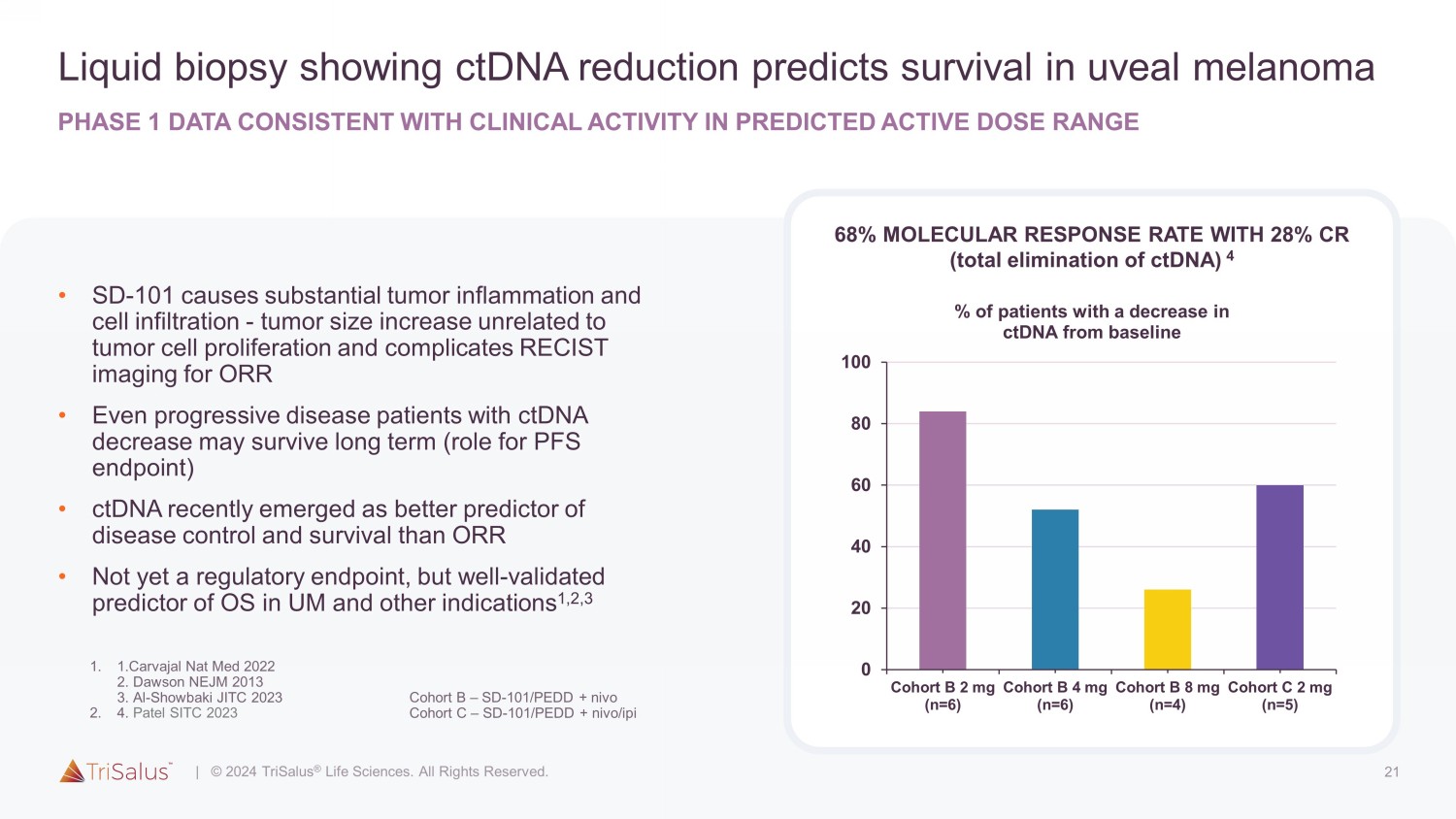
21 Liquid biopsy showing ctDNA reduction predicts survival in uveal melanoma PHASE 1 DATA CONSISTENT WITH CLINICAL ACTIVITY IN PREDICTED ACTIVE DOSE RANGE • SD - 101 causes substantial tumor inflammation and cell infiltration - tumor size increase unrelated to tumor cell proliferation and complicates RECIST imaging for ORR • Even progressive disease patients with ctDNA decrease may survive long term (role for PFS endpoint) • ctDNA recently emerged as better predictor of disease control and survival than ORR • Not yet a regulatory endpoint, but well - validated predictor of OS in UM and other indications 1,2,3 Patel SITC 2023 68% MOLECULAR RESPONSE RATE WITH 28% CR (total elimination of ctDNA ) 4 0 20 40 60 80 100 Cohort B 2 mg (n=6) Cohort B 4 mg (n=6) Cohort B 8 mg (n=4) Cohort C 2 mg (n=5) % of patients with a decrease in ctDNA from baseline
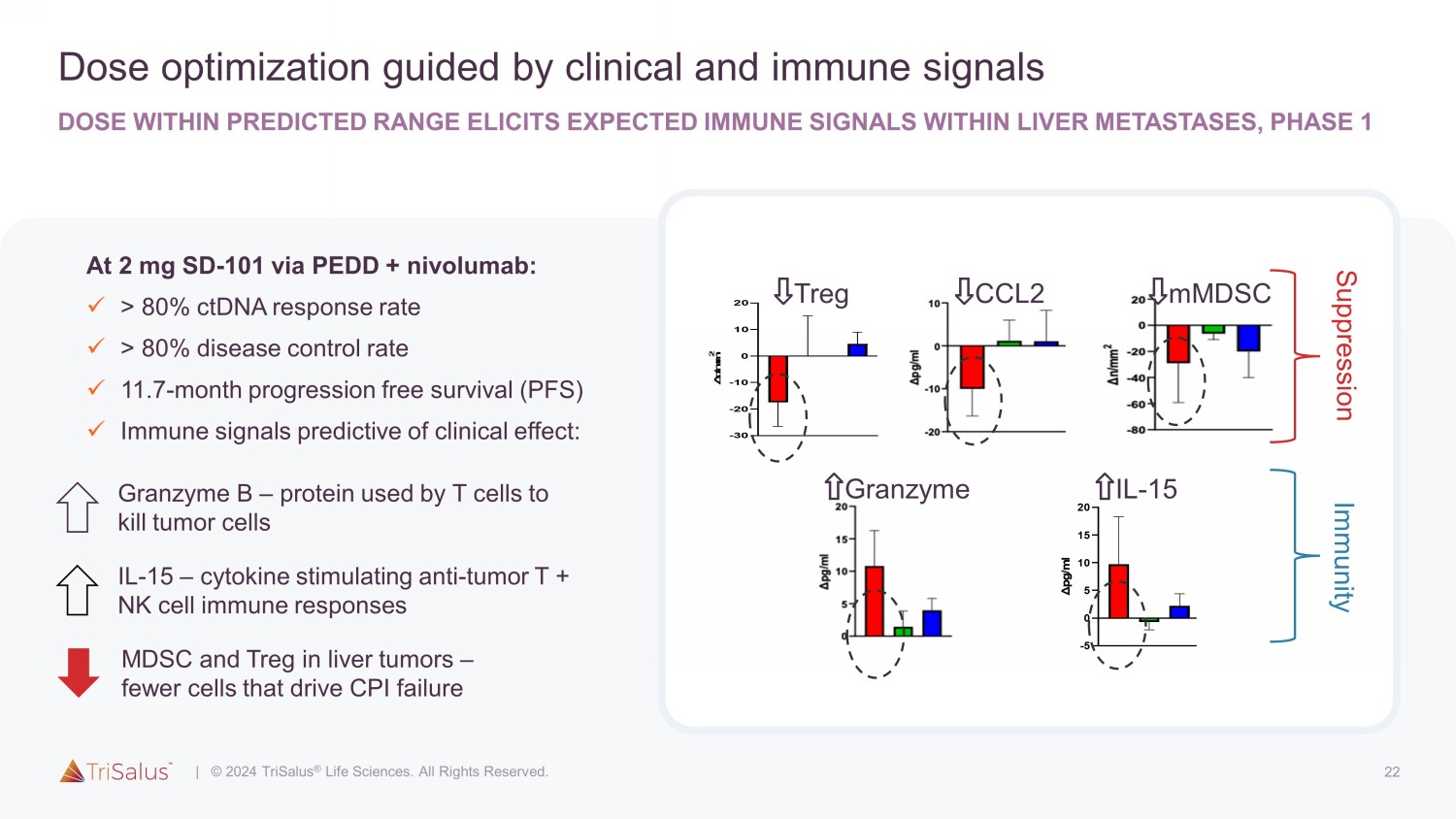
22 Dose optimization guided by clinical and immune signals DOSE WITHIN PREDICTED RANGE ELICITS EXPECTED IMMUNE SIGNALS WITHIN LIVER METASTASES, PHASE 1 At 2 mg SD - 101 via PEDD + nivolumab: x > 80% ctDNA response rate x > 80% disease control rate x 11.7 - month progression free survival (PFS) x Immune signals predictive of clinical effect: -30 -20 -10 0 10 20 PERIO1: Change in Tregs (Day1- 57) Δ n / m m 2 SD-101 8mg (n=4) SD-101 2mg (n=6) SD-101 4mg (n=5) ⇩ Treg ⇩ CCL2 ⇩ mMDSC ⇧ Granzyme ⇧ IL - 15 Immunity Suppression Granzyme B – protein used by T cells to kill tumor cells IL - 15 – cytokine stimulating anti - tumor T + NK cell immune responses MDSC and Treg in liver tumors – fewer cells that drive CPI failure
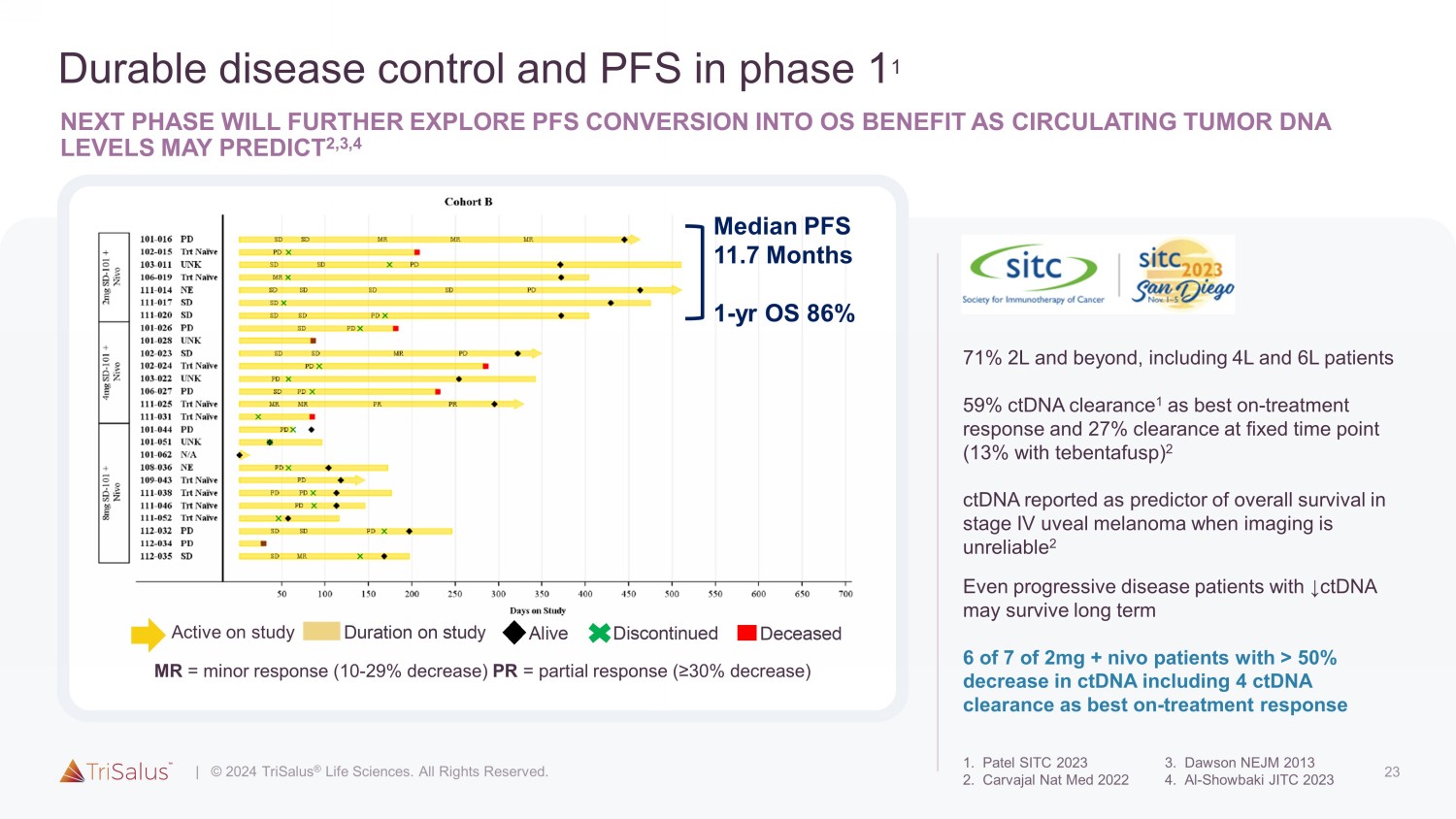
23 Durable disease control and PFS in phase 1 1 NEXT PHASE WILL FURTHER EXPLORE PFS CONVERSION INTO OS BENEFIT A S CIRCULATING TUMOR DNA LEVELS MAY PREDICT 2,3,4 71% 2L and beyond, including 4L and 6L patients 59% ctDNA clearance 1 as best on - treatment response and 27% clearance at fixed time point (13% with tebentafusp) 2 ctDNA reported as predictor of overall survival in stage IV uveal melanoma when imaging is unreliable 2 Even progressive disease patients with ↓ ctDNA may survive long term 6 of 7 of 2mg + nivo patients with > 50% decrease in ctDNA including 4 ctDNA clearance as best on - treatment response Alive Deceased Discontinued Duration on study MR = minor response (10 - 29% decrease) PR = partial response (≥30% decrease) Active on study Median PFS 11.7 Months 1 - yr OS 86%
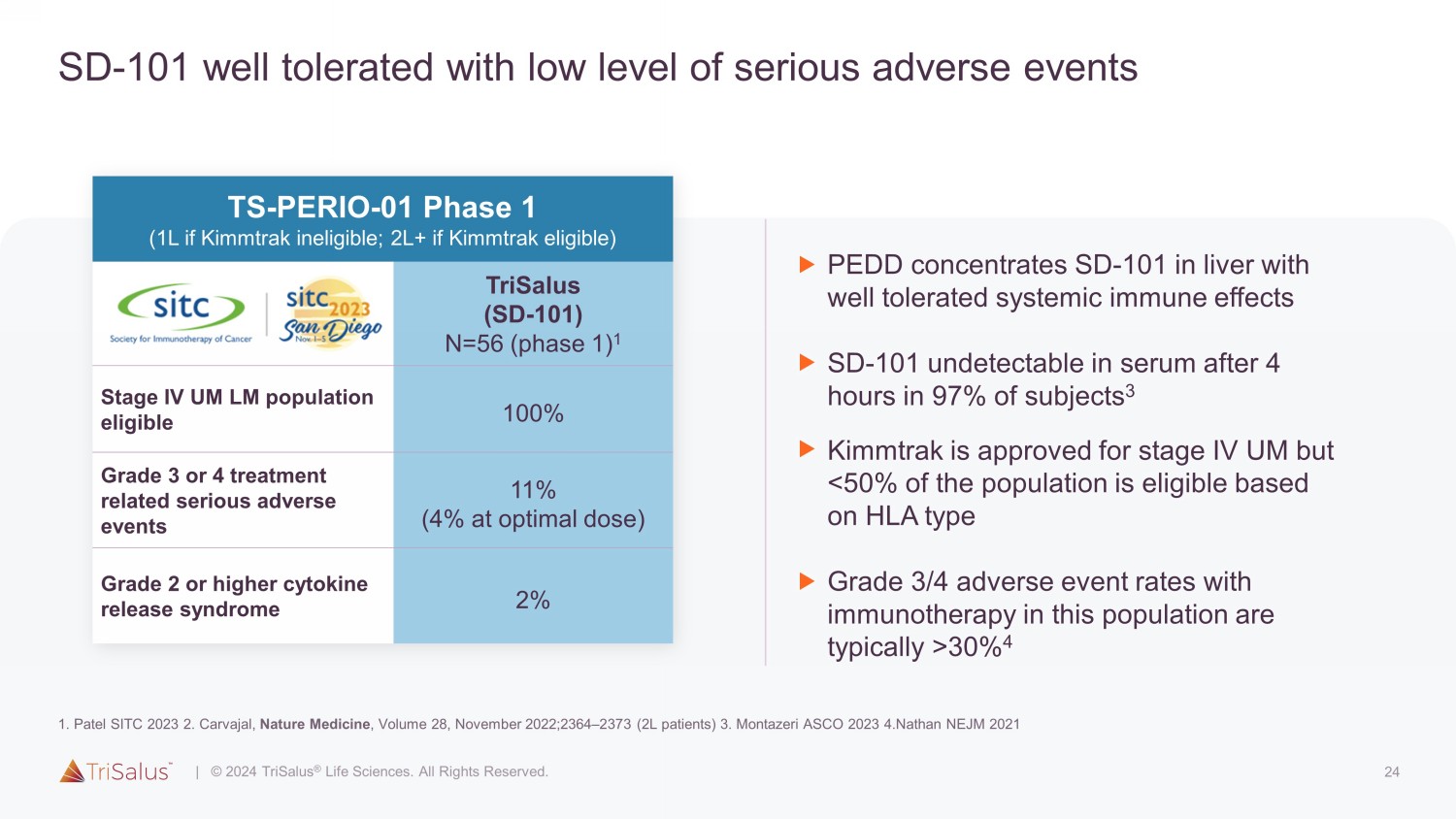
24 SD - 101 well tolerated with low level of serious adverse events TS - PERIO - 01 Phase 1 (1L if Kimmtrak ineligible; 2L+ if Kimmtrak eligible) TriSalus (SD - 101) N=56 (phase 1) 1 Stage IV UM LM population eligible 100% Grade 3 or 4 treatment related serious adverse events 11% (4% at optimal dose) Grade 2 or higher cytokine release syndrome 2% PEDD concentrates SD - 101 in liver with well tolerated systemic immune effects SD - 101 undetectable in serum after 4 hours in 97% of subjects 3 Kimmtrak is approved for stage IV UM but <50% of the population is eligible based on HLA type Grade 3/4 adverse event rates with immunotherapy in this population are typically >30% 4
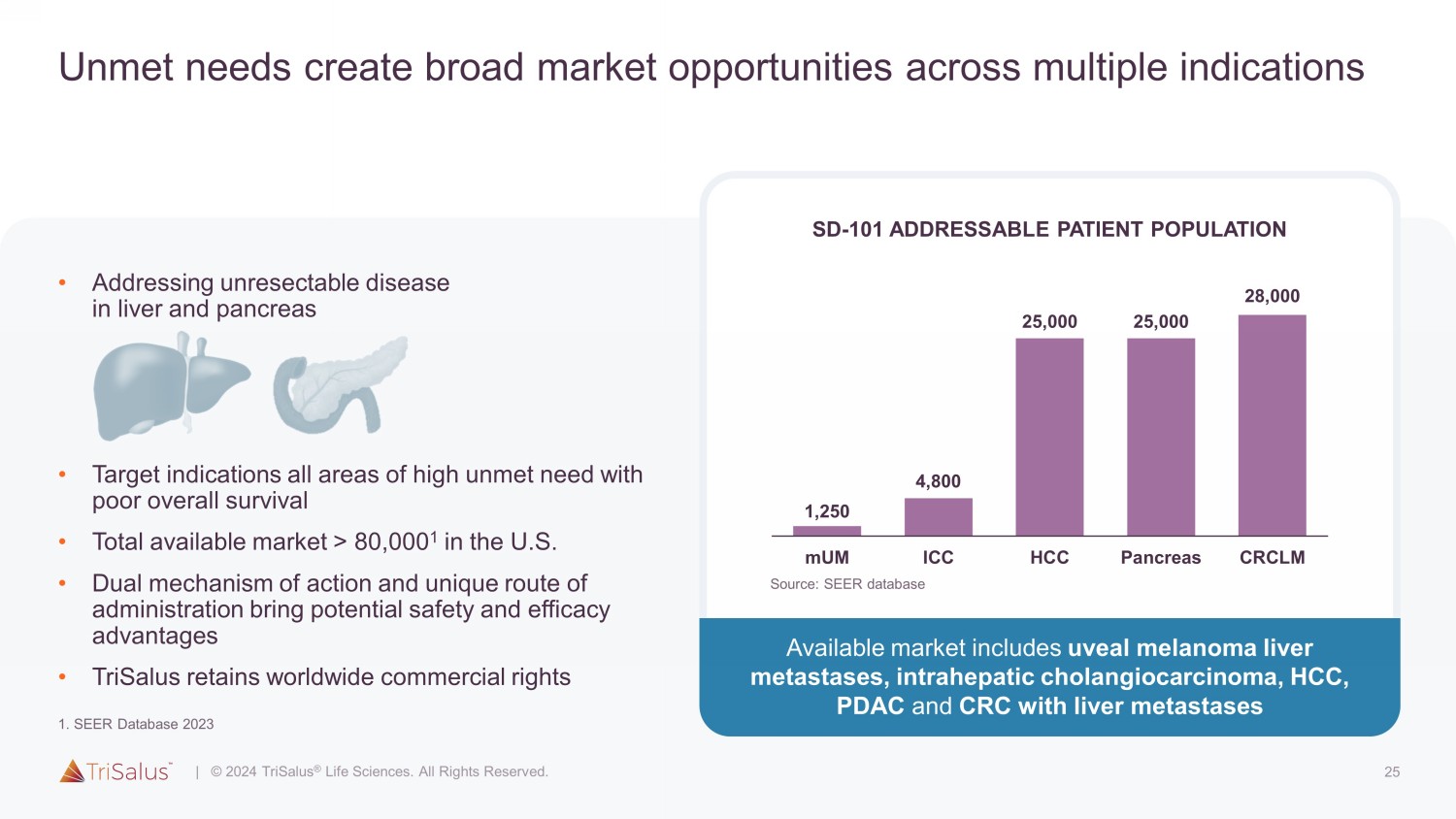
25 Unmet needs create broad market opportunities across multiple indications • Addressing unresectable disease in liver and pancreas • Target indications all areas of high unmet need with poor overall survival • Total available market > 80,000 1 in the U.S. • Dual mechanism of action and unique route of administration bring potential safety and efficacy advantages • TriSalus retains worldwide commercial rights SD - 101 ADDRESSABLE PATIENT POPULATION 1,250 4,800 25,000 25,000 28,000 mUM ICC HCC Pancreas CRCLM Available market includes uveal melanoma liver metastases, intrahepatic cholangiocarcinoma, HCC, PDAC and CRC with liver metastases
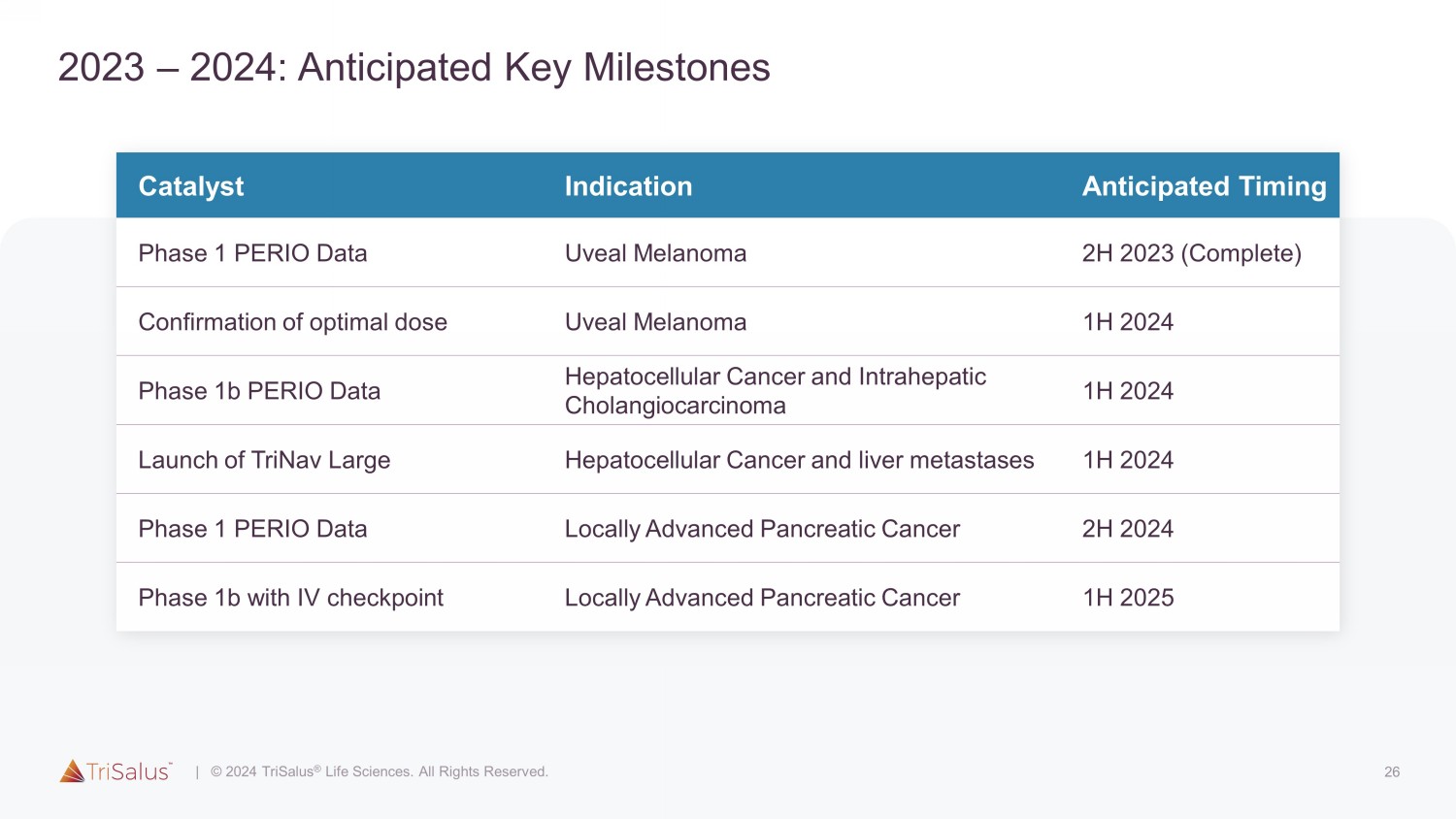
26 2023 – 2024: Anticipated Key Milestones Catalyst Indication Anticipated Timing Phase 1 PERIO Data Uveal Melanoma 2H 2023 (Complete) Confirmation of optimal dose Uveal Melanoma 1H 2024 Phase 1b PERIO Data Hepatocellular Cancer and Intrahepatic Cholangiocarcinoma 1H 2024 Launch of TriNav Large Hepatocellular Cancer and liver metastases 1H 2024 Phase 1 PERIO Data Locally Advanced Pancreatic Cancer 2H 2024 Phase 1b with IV checkpoint Locally Advanced Pancreatic Cancer 1H 2025
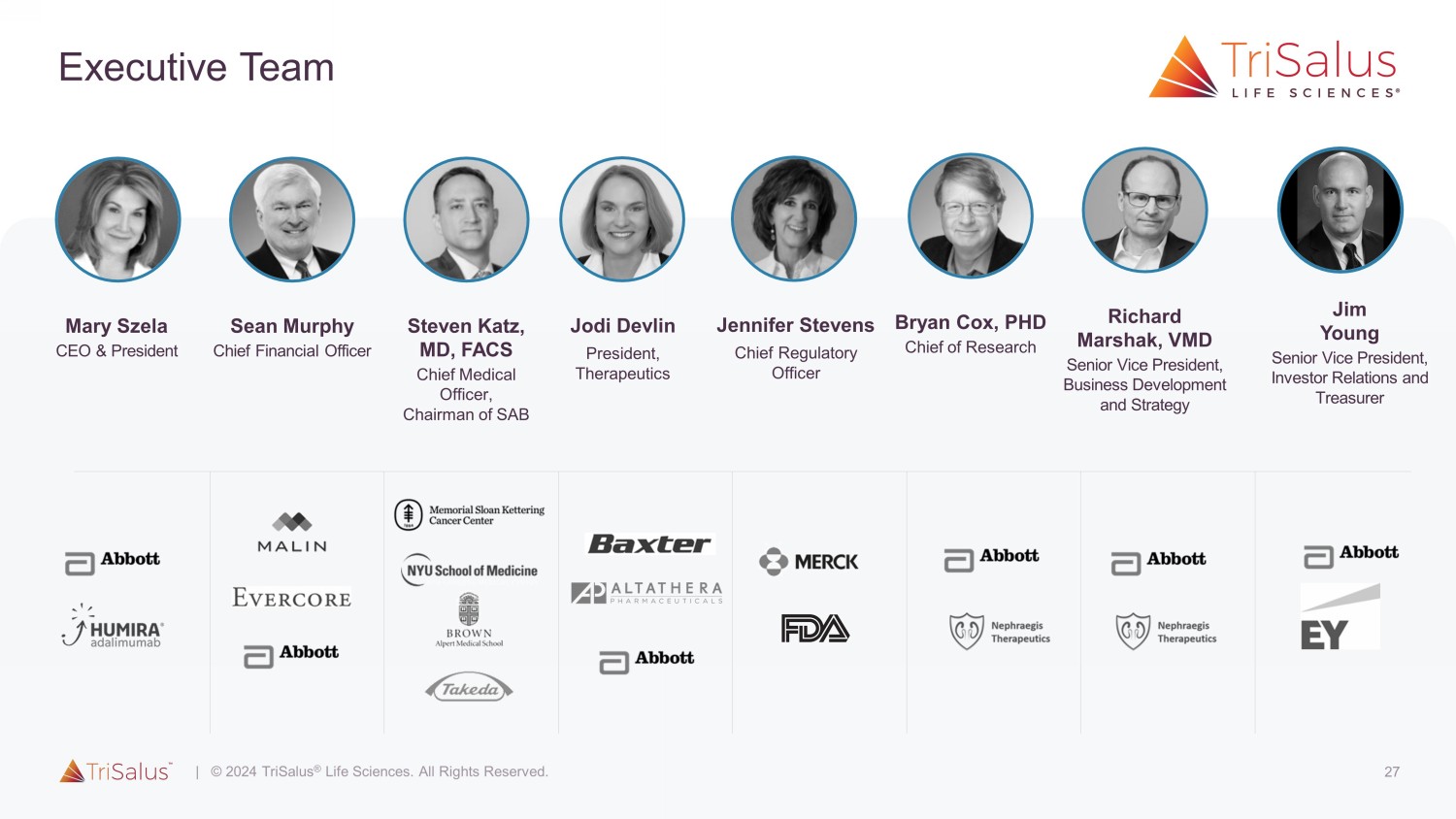
27 Executive Team Jodi Devlin President, Therapeutics Mary Szela CEO & President Sean Murphy Chief Financial Officer Steven Katz, MD, FACS Chief Medical Officer, Chairman of SAB Jennifer Stevens Chief Regulatory Officer Bryan Cox, PHD Chief of Research Richard Marshak, VMD Senior Vice President, Business Development and Strategy Jim Young Senior Vice President, Investor Relations and Treasurer
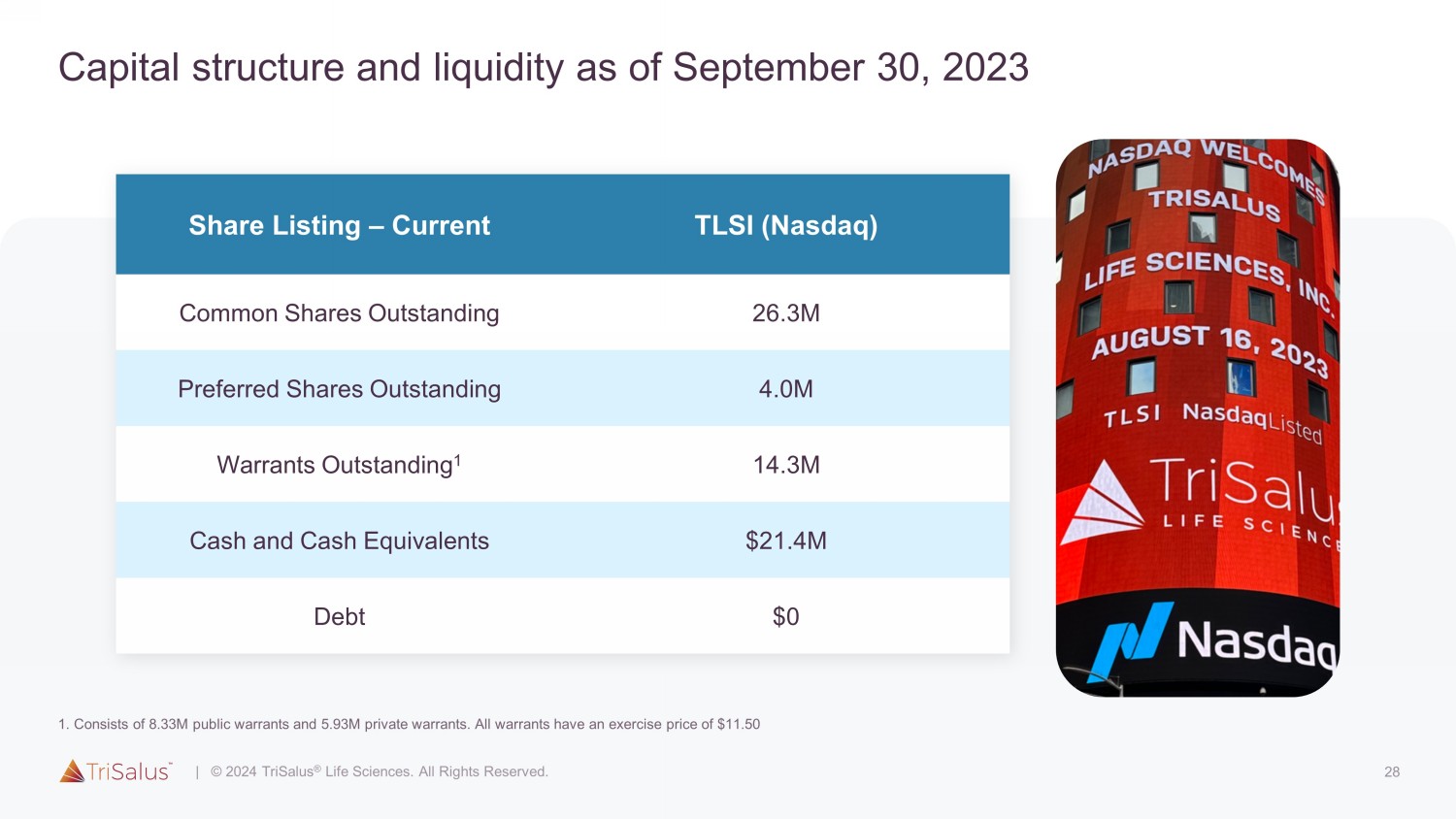
28 Capital structure and liquidity as of September 30, 2023 Share Listing – Current TLSI (Nasdaq) Common Shares Outstanding 26.3M Preferred Shares Outstanding 4.0M Warrants Outstanding 1 14.3M Cash and Cash Equivalents $21.4M Debt $0
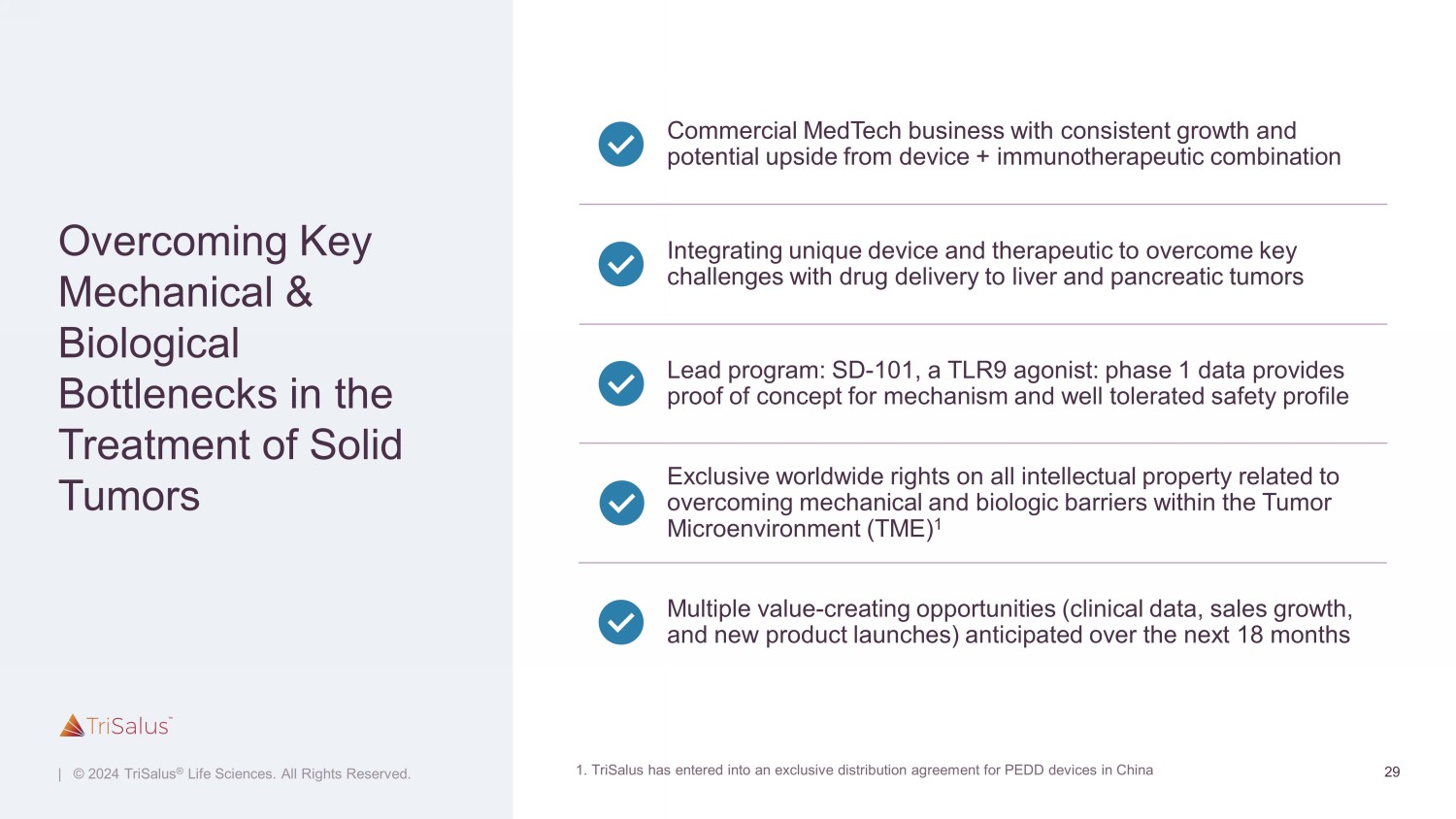
29 ` Overcoming Key Mechanical & Biological Bottlenecks in the Treatment of Solid Tumors Commercial MedTech business with consistent growth and potential upside from device + immunotherapeutic combination Integrating unique device and therapeutic to overcome key challenges with drug delivery to liver and pancreatic tumors Lead program: SD - 101, a TLR9 agonist: phase 1 data provides proof of concept for mechanism and well tolerated safety profile Multiple value - creating opportunities (clinical data, sales growth, and new product launches) anticipated over the next 18 months Exclusive worldwide rights on all intellectual property related to overcoming mechanical and biologic barriers within the Tumor Microenvironment (TME) 1
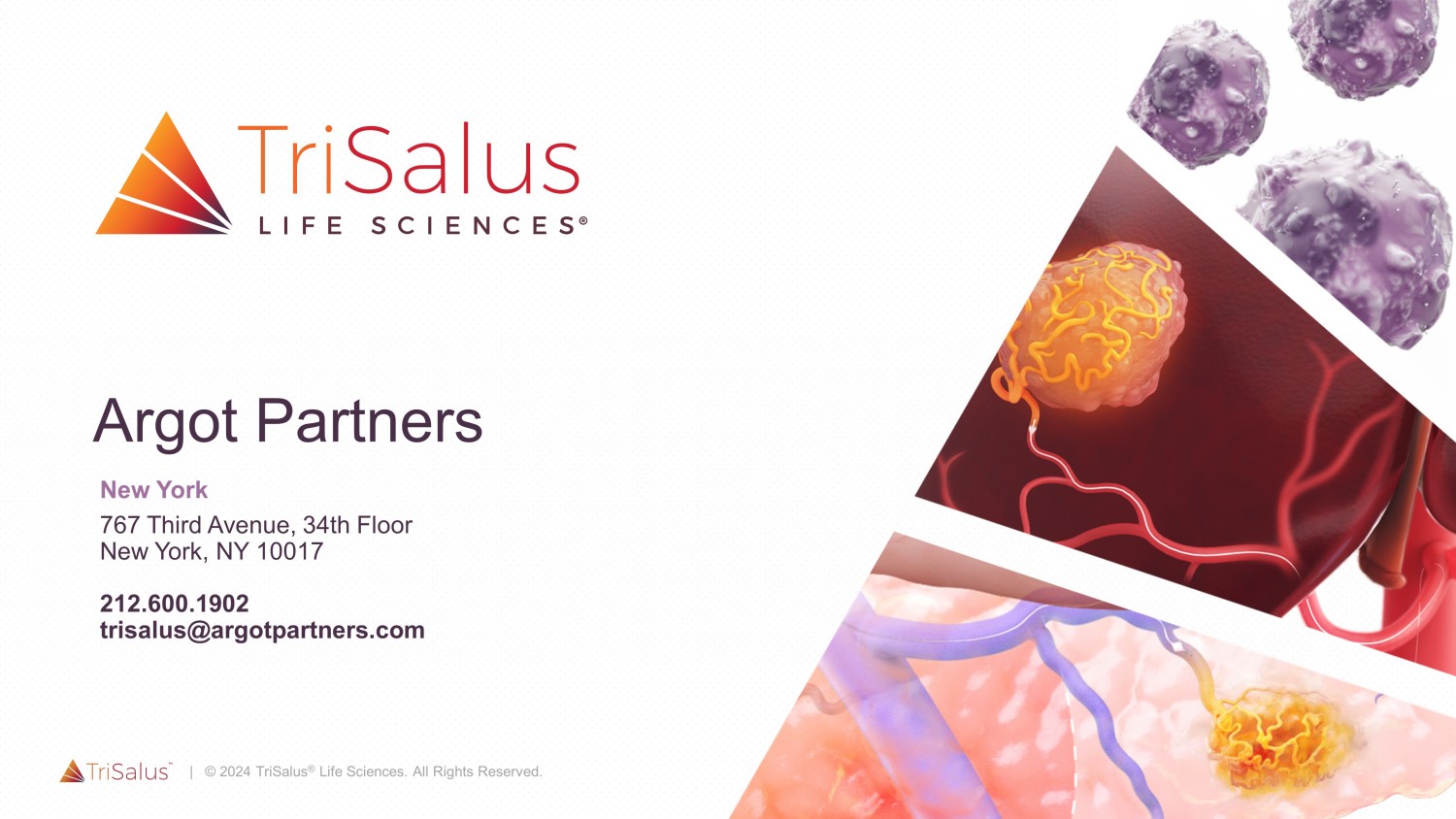
30 Argot Partners New York 767 Third Avenue, 34th Floor New York, NY 10017 212.600.1902 trisalus@argotpartners.com | © 2024 TriSalus ® Life Sciences. All Rights Reserved.
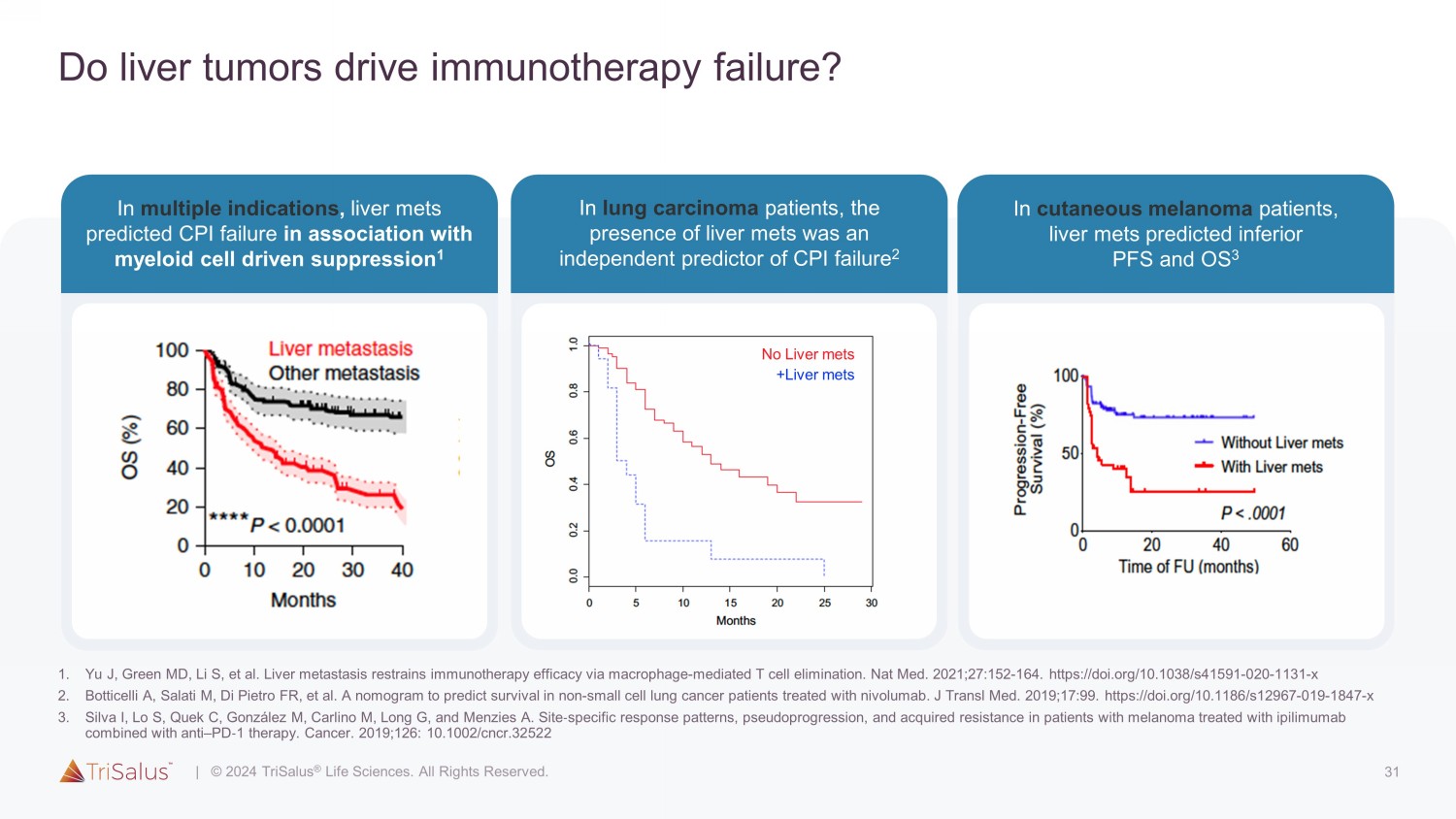
31 Do liver tumors drive immunotherapy failure? In multiple indications , liver mets predicted CPI failure in association with myeloid cell driven suppression 1 In cutaneous melanoma patients, liver mets predicted inferior PFS and OS 3 In lung carcinoma patients, the presence of liver mets was an independent predictor of CPI failure 2 +Liver mets No Liver mets
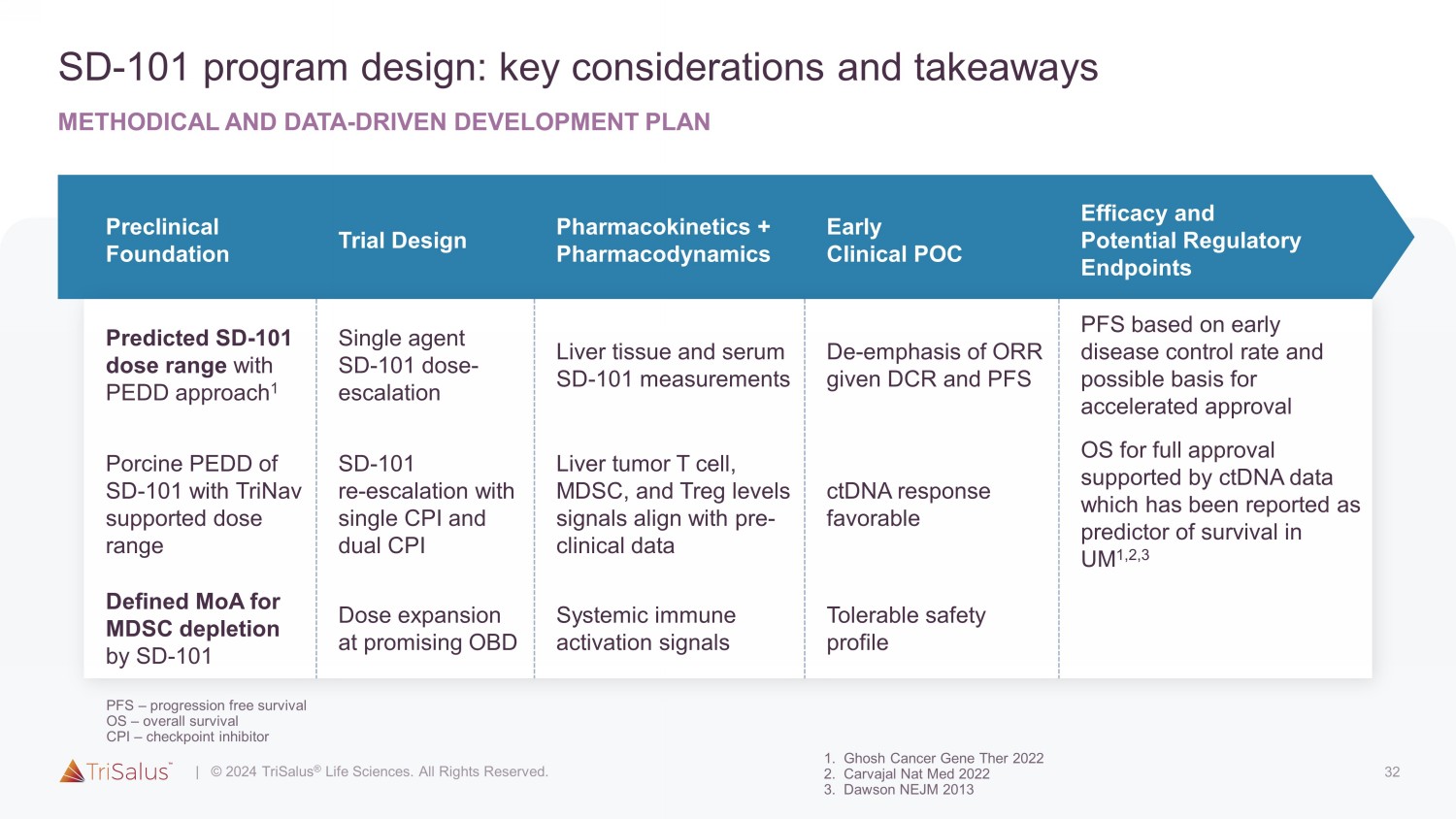
32 SD - 101 program design: key considerations and takeaways METHODICAL AND DATA - DRIVEN DEVELOPMENT PLAN Preclinical Foundation Trial Design Pharmacokinetics + Pharmacodynamics Early Clinical POC Efficacy and Potential Regulatory Endpoints Predicted SD - 101 dose range with PEDD approach 1 Single agent SD - 101 dose - escalation Liver tissue and serum SD - 101 measurements De - emphasis of ORR given DCR and PFS PFS based on early disease control rate and possible basis for accelerated approval Porcine PEDD of SD - 101 with TriNav supported dose range SD - 101 re - escalation with single CPI and dual CPI Liver tumor T cell, MDSC, and Treg levels signals align with pre - clinical data ctDNA response favorable OS for full approval supported by ctDNA data which has been reported as predictor of survival in UM 1,2,3 Defined MoA for MDSC depletion by SD - 101 Dose expansion at promising OBD Systemic immune activation signals Tolerable safety profile
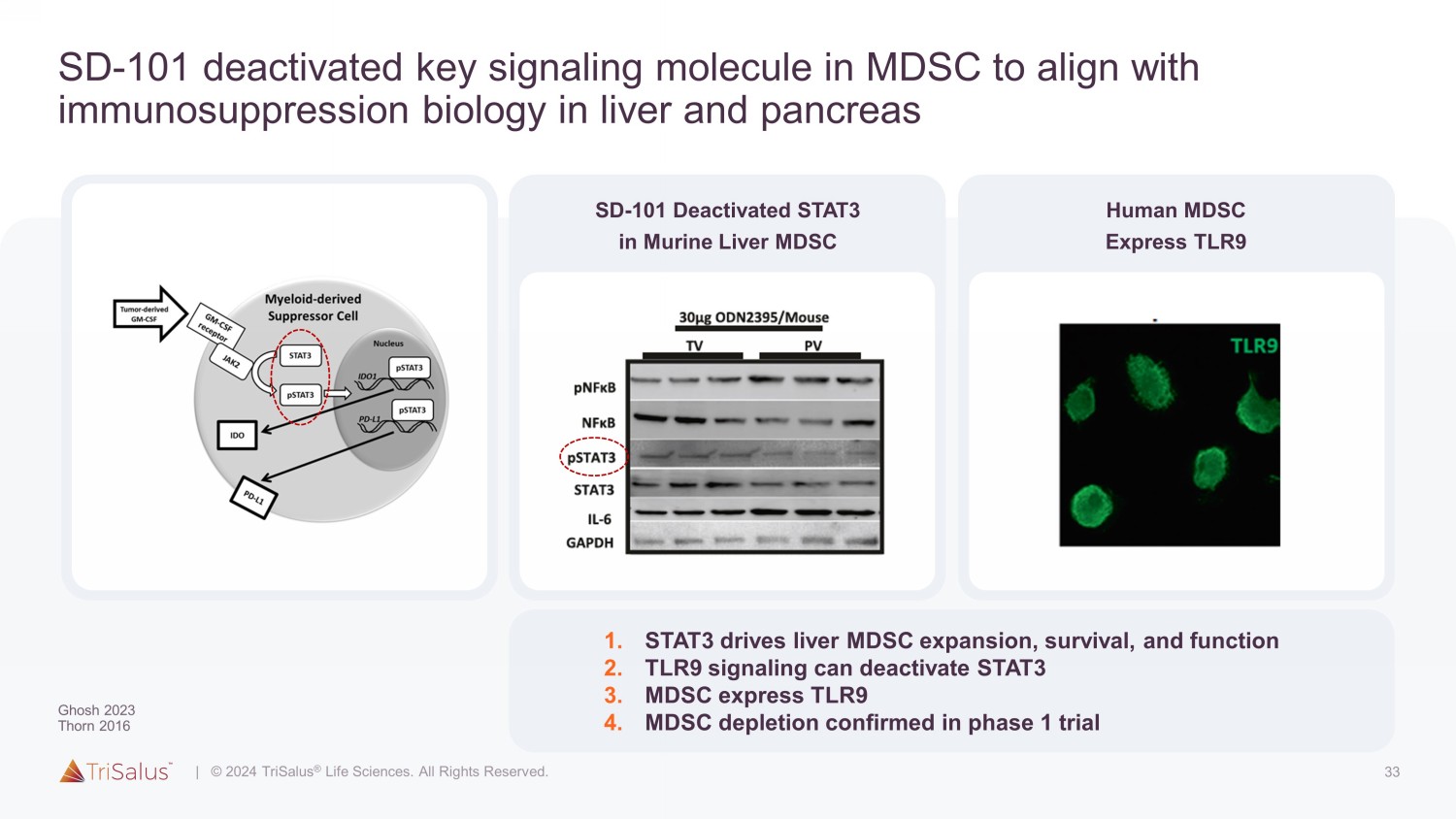
33 SD - 101 deactivated key signaling molecule in MDSC to align with immunosuppression biology in liver and pancreas SD - 101 Deactivated STAT3 in Murine Liver MDSC Human MDSC Express TLR9 1. STAT3 drives liver MDSC expansion, survival, and function 2. TLR9 signaling can deactivate STAT3 3. MDSC express TLR9 4. MDSC depletion confirmed in phase 1 trial
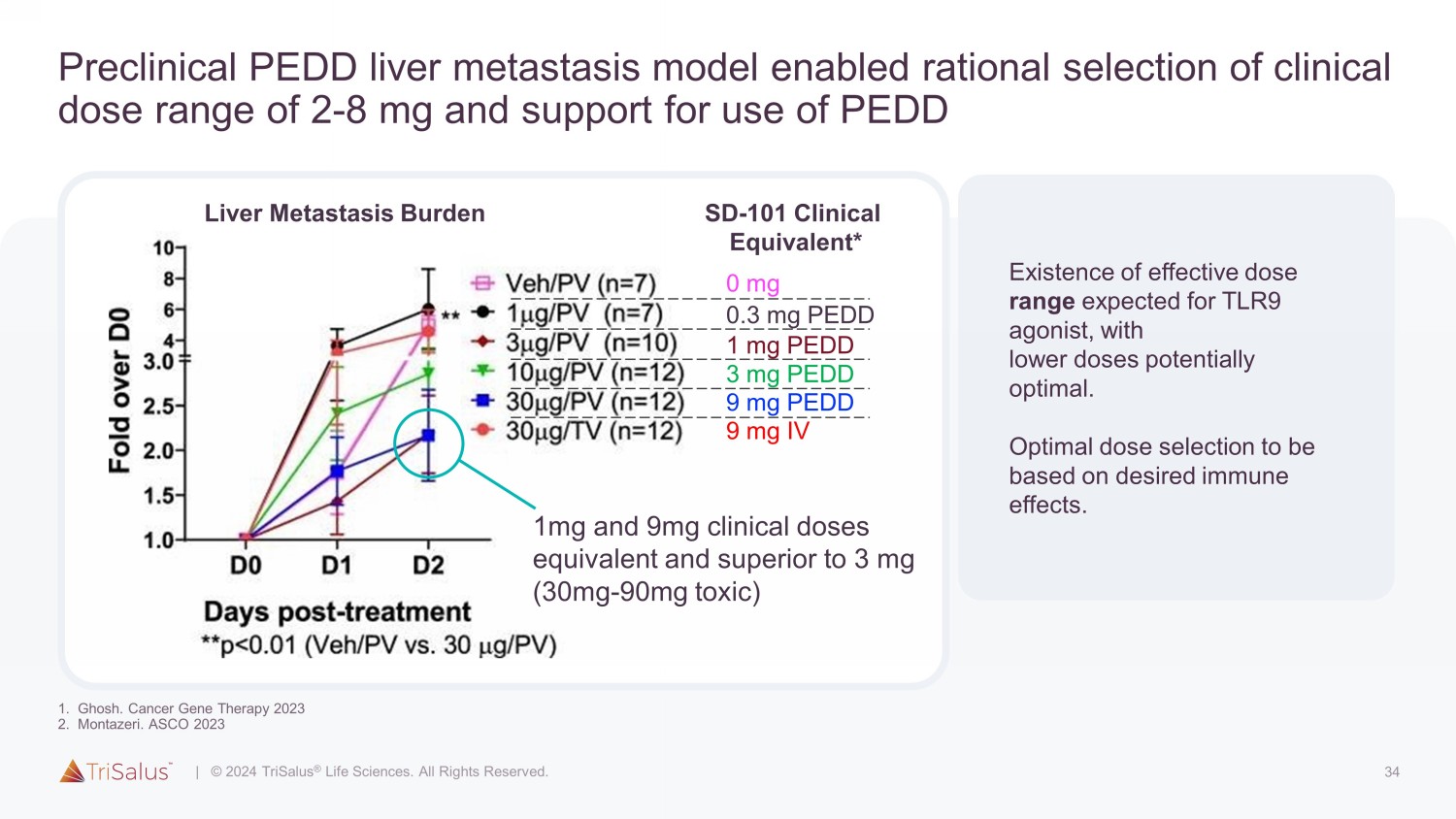
34 Preclinical PEDD liver metastasis model enabled rational selection of clinical dose range of 2 - 8 mg and support for use of PEDD Existence of effective dose range expected for TLR9 agonist, with lower doses potentially optimal. Optimal dose selection to be based on desired immune effects. Liver Metastasis Burden SD - 101 Clinical Equivalent* 0 mg 0.3 mg PEDD 1 mg PEDD 3 mg PEDD 9 mg PEDD 9 mg IV 1mg and 9mg clinical doses equivalent and superior to 3 mg (30mg - 90mg toxic)
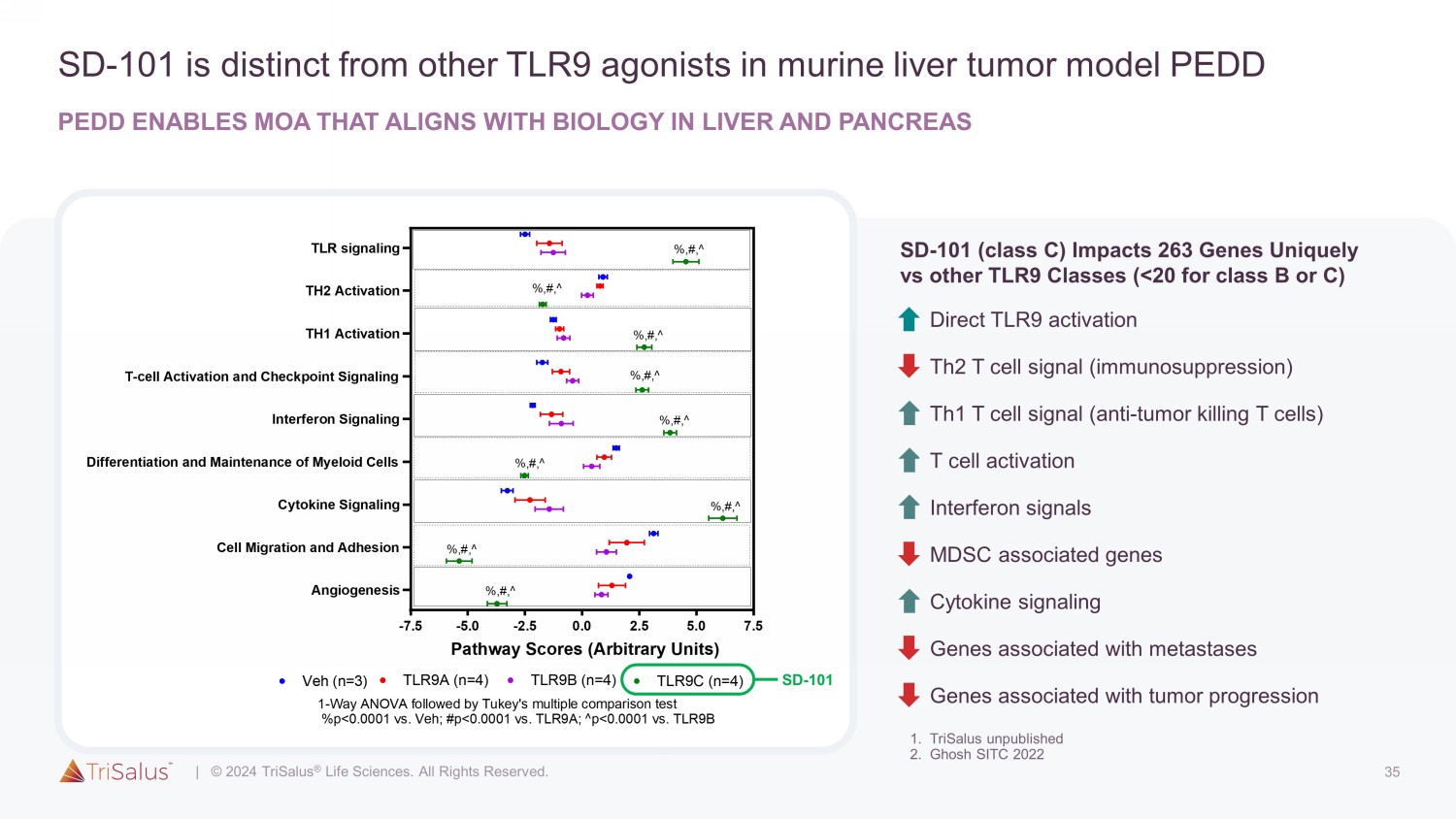
35 SD - 101 is distinct from other TLR9 agonists in murine liver tumor model PEDD PEDD ENABLES MOA THAT ALIGNS WITH BIOLOGY IN LIVER AND PANCREAS -7.5 -5.0 -2.5 0.0 2.5 5.0 7.5 Angiogenesis Cell Migration and Adhesion Cytokine Signaling Differentiation and Maintenance of Myeloid Cells Interferon Signaling T-cell Activation and Checkpoint Signaling TH1 Activation TH2 Activation TLR signaling Veh (n=3) TLR9B (n=4) TLR9C (n=4) TLR9A (n=4) Pathway Scores (Arbitrary Units) %,#,^ %,#,^ %,#,^ %,#,^ %,#,^ %,#,^ %,#,^ %,#,^ %,#,^ 1-Way ANOVA followed by Tukey's multiple comparison test %p<0.0001 vs. Veh; #p<0.0001 vs. TLR9A; ^p<0.0001 vs. TLR9B SD - 101 Direct TLR9 activation Th2 T cell signal (immunosuppression) Th1 T cell signal (anti - tumor killing T cells) T cell activation Interferon signals MDSC associated genes Cytokine signaling Genes associated with metastases Genes associated with tumor progression SD - 101 (class C) Impacts 263 Genes Uniquely vs other TLR9 Classes (<20 for class B or C)
1 Year TriSalus Life Sciences Chart |
1 Month TriSalus Life Sciences Chart |

It looks like you are not logged in. Click the button below to log in and keep track of your recent history.
Support: +44 (0) 203 8794 460 | support@advfn.com
By accessing the services available at ADVFN you are agreeing to be bound by ADVFN's Terms & Conditions